










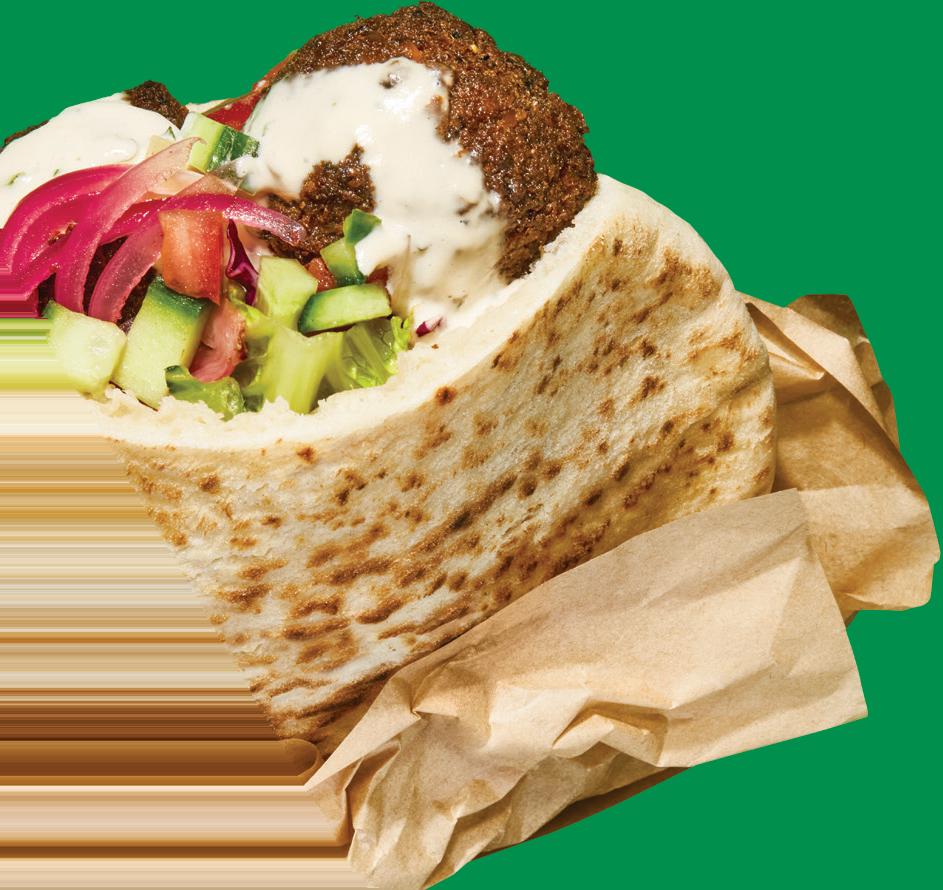

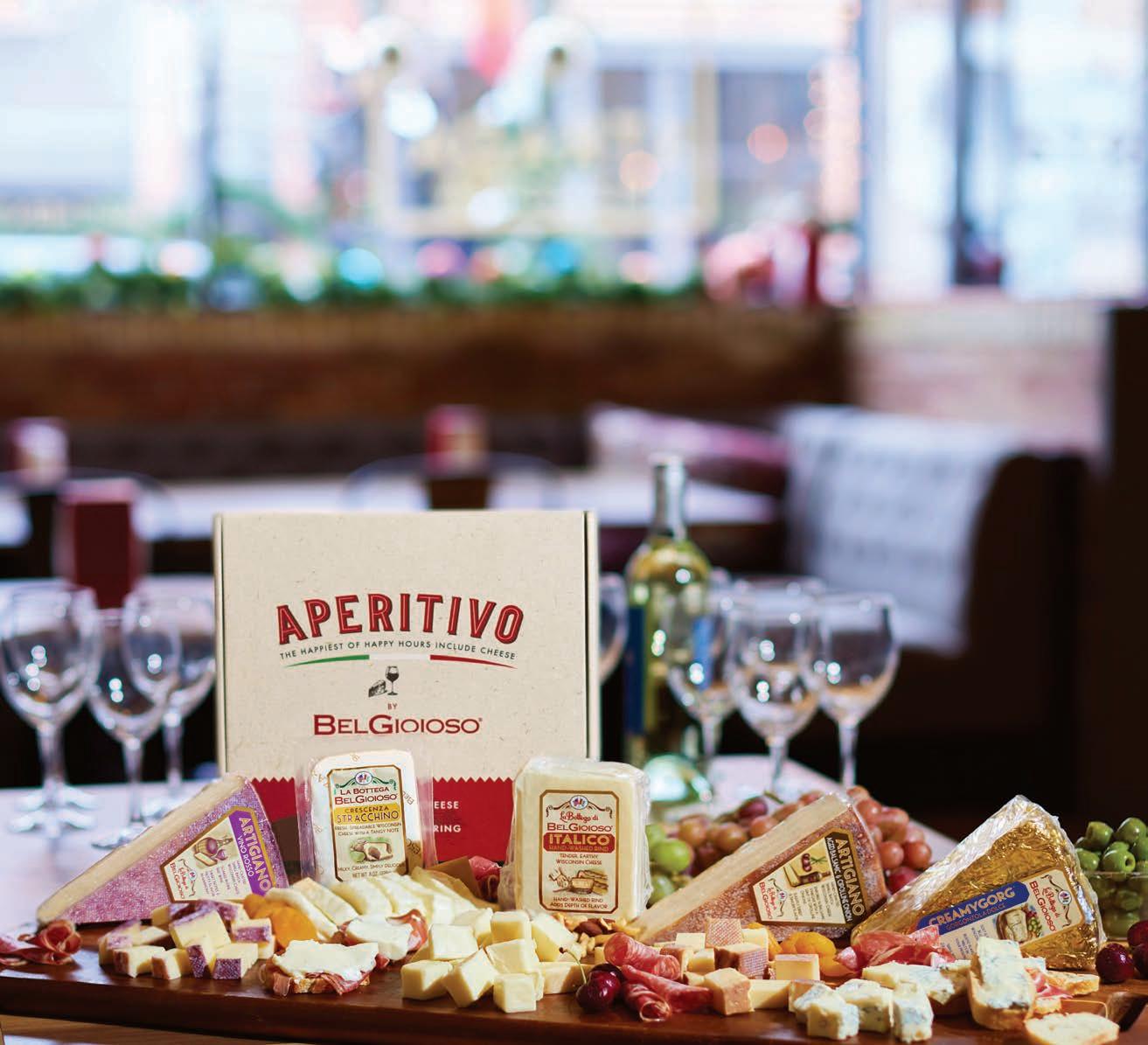
ARTIGIANO®
VINO ROSSO


nutty, crumbly texture
CRESCENZA STRACCHINO™

milky, tart flavor and soft, creamy texture

ASK US ABOUT

ITALICO™ WASHED RIND CHEESE


earthy, full flavor and soft texture
ARTIGIANO®








AGED BALSAMIC & CIPOLLINE ONION
nutty, full and sharp flavor
CREAMYGORG® GORGONZOLA DOLCE

earthy flavor and creamy texture
CONTACT US FOR SAMPLES

belgioioso.com/foodservice

The allure and beauty of Hawaiian cuisine comes from its surroundings and people. Here’s a closer look at this regional American cuisine blending multiple cultures.
14
18
24
26
34
Management
Handling security in the kitchen is never an easy task, but these experts offer some key tips.
ACF chefs talk about the culinary traditions they enjoy on Juneteenth, an important holiday.
Cocktails and cheese might sound like an unusual pairing, but they bring endless delight to diners.
ACF Chef Robert Marilla, CEC, AAC, prepares a classic Spanish paella and a modern version.
Health
For Mental Health Awareness Month, here’s a look at Ben’s Friends, just one of ACF’s wellness partner organizations.
36
42
Club and resort chefs detail how they’re ramping up their banquet programs.
Pastry
Baked Alaska never fails to impress: an exploration of this icy-hot dessert.
Peter Merriman, Merriman’s Restaurants, Hawaii
Steven Nakata, Kauai Community College, Lihue, Hawaii
Brian Tatsukawa, CEC, Navajo Technical University, Crownpoint, New Mexico
Robert Witte, CEC, CCA, AAC, Navajo Technical University, Crownpoint, New Mexico
Jack Birren, CEC, Waukesha County Technical College, Pewaukee, Wisconsin
Brian Beland, CMC, AAC, Country Club of Detroit, Grosse Pointe Farms, Michigan
Jonathan Moosmiller, CMC, AAC, Shangri-La Resort and Golf Club, Monkey Island, Oklahoma
Jennifer Hill Booker (ChefJenniferHillBooker.com) is a cookbook author and owner of the recently opened Bauhaus Biergarten in Springdale, Arkansas
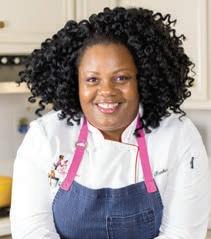
Jennifer Hill Booker
ACF Chef Robert Marilla, CEC, culinary arts department chair, Central Piedmont Community College, Charlotte, North Carolina
Glenn
Robert Marilla, CEC
Glenn Rinsky, CEPC, CEC, CCE, is a chef-instructor at Jefferson State Community College, Birmingham, Alabama, and produces the YouTube Channel, Grand Cuisine!


Editor-in-Chief
Amelia Levin
Creative Services Manager
David Ristau
Graphic Designer
Armando Mitra
Advertising and Event Sales
Eric Gershowitz
Director of Marketing and Communications
Alan Sterling
Contributing Editors
Amanda Baltazar, John Bartimole, Robin Caldwell, Jennifer Hill Booker, Howard Riell, Glenn Rinsky, Jody Shee
Copy Editor
Erica Demarest
American Culinary Federation, Inc. 6816 Southpoint Parkway Ste 400 Jacksonville, FL 32216 (800) 624-9458 (904) 824-4468 Fax: (904) 940-0741 ncr@acfchefs.net ACFSales@mci-group.com www.acfchefs.org
Board of Directors
President
Kimberly Brock Brown, CEPC®, CCA®, AAC®

Immediate Past President
Thomas Macrina, CEC®, CCA, AAC
National Secretary
Jeff Bacon, CEC, CCA, AAC
National Treasurer
Kent Andersen, CEC, CCA, AAC
American Academy of Chefs Chair
Americo “Rico” DiFronzo, CEC, CCA, AAC
Vice President Central Region
Rajeev Patgaonkar, CEC, AAC
Vice President Northeast Region
Barry R. Young, CEC, CCE®, AAC, MBA
Vice President Southeast Region
Bryan Frick, CEC, AAC
Vice President Western Region
Greg Matchett, CEC, AAC
Executive Director
Heidi Cramb
We’re only a couple months away from the 2023 ACF National Convention! I am super excited for this year’s event and that we’ll be in New Orleans — one of my favorite cities.
First, I want to give a huge shoutout and thank you to our returning and new sponsors for this year’s event; we wouldn’t be able to host it without you! Did you know that we had 53 NEW companies investing in sponsorships with ACF in 2022 that did not spend in 2021? That equates to a 34% growth in NEW revenue generated by our sales team! All of this support goes right back to you, our growing group of members (we’ve increased our numbers 3% year-over-year with 12,644 members) in the form of topnotch education and networking opportunities.
Speaking of education, our growing list of convention speakers continues to amaze me. Turn to page 46 for a list of some of the sessions covering topics like Creole cuisine, ways to manage the workforce crisis, advanced baking, cooking with cannabis and more! Also, you won’t want to miss this year’s welcome reception, which will be held at the absolutely gorgeous New Orleans Culinary & Hospitality Institute (NOCHI) on the first night of convention. Convention is the best time to welcome new members into our group. Let’s reconnect with old friends and make new ones! Last year we had more than 1,000 attendees — on the heels of the pandemic — and we’re predicting an even larger group this year.
Calling all culinary educators! The Advanced Culinary Educator Summit, the first of the ACF MasterCraft Summit Series planned for this year, will be held on the Sunday prior to convention at the Ernest N. Morial Convention Center. This is a great way to get in a day of learning and CEHs before the week kicks off.
(ACF) and is produced six times per year by ACF, located at 6816 Southpoint Parkway, Ste 400, Jacksonville, FL 32216. A digital subscription to the National Culinary Review® is included with ACF membership dues; print subscriptions are available to ACF members for $25 per year, domestic; nonmember subscriptions are $40. Material from the National Culinary Review®, in whole or in part, may not be reproduced without written permission. All views and opinions expressed in the National Culinary Review® are those of the author and do not necessarily reflect the views and opinions of the officers or members of ACF. Changes of mailing address should be sent to ACF’s national office: 6816 Southpoint Parkway, Ste 400, Jacksonville, FL 32216; (800) 624-9458; Fax (904) 940-0741.
The National Culinary Review® is mailed, and periodical postage is paid at St. Augustine, Fla., and additional post offices.
POSTMASTER: Send address changes to the National Culinary Review®, 6816 Southpoint Parkway, Ste 400, Jacksonville, FL 32216.

Competitions are ramping up, as well. I was thrilled to have been able to watch the ACF National Qualifiers in March and see the professional and student chefs who will go on to compete at convention. Special thanks to the folks at Johnson County Community College and all the amazing volunteers and judges who helped out!
There’s other cause for celebration in May and June, including Mental Health Awareness Month (for resources, turn to p. 34), Asian American and Pacific Islander Heritage Month (read about Hawaiian cuisine on p. 28) and Juneteenth (ACF Chef Jennifer Hill Booker talks traditions on p. 18). And let’s not forget Mother’s Day and Father’s Day — here’s a shoutout to our hard-working parents out there! Will I see you all at convention?
Let’s go!
Kimberly Brock Brown, CEPC, CCA, AAC National President, American Culinary FederationContact

¡Faltan solo un par de meses para la Convención Nacional de la ACF de 2023! Estoy muy emocionada por el evento de este año y porque estaremos en Nueva Orleans, una de mis ciudades favoritas.
En primer lugar quiero enviar un enorme saludo y agradecimiento a nuestros patrocinadores de siempre y a los que se sumaron para el evento de este año; ¡esto no sería posible sin ustedes! ¿Sabían que en 2022 hubo 53 NUEVAS empresas que decidieron invertir en patrocinios y que no nos acompañaban en 2021? ¡Eso equivale a un crecimiento del 34% en NUEVAS ganancias generadas por nuestro equipo de ventas! Y todo este apoyo les vuelve a ustedes, nuestros miembros, que son cada vez más (hemos aumentado un 3% nuestra cantidad de miembros de un año al siguiente, ahora son 12.644) en la forma de oportunidades de colaboración y formación de primera calidad.
Hablando de formación, nuestra creciente lista de oradores para la convención no deja de asombrarme. Consulten la página 46 para conocer una lista de algunas de las sesiones que abarcarán temas como la cocina criolla, formas de manejar la crisis laboral, repostería avanzada, cocina con cannabis y más. Además, no querrán perderse la gala de bienvenida de este año, que se llevará a cabo en el magnífico New Orleans Culinary & Hospitality Institute (NOCHI) la primera noche de la convención. La convención es el mejor momento para dar la bienvenida a los nuevos miembros a nuestro grupo. ¡Volvamos a ponernos en contacto con viejos amigos y hagamos otros nuevos! El año pasado contamos con más de 1000 participantes, inmediatamente después de la pandemia, y prevemos un grupo aún mayor para este año.
¡Este es un llamado para todos los docentes culinarios! La Cumbre de Docentes Culinarios Avanzados, la primera de la Serie de Cumbres MasterCraft de la ACF de este año, se llevará a cabo el domingo anterior a la convención en el Centro de Convenciones Ernest N. Morial. Esta es una excelente manera de comenzar un día de aprendizaje y colaboración antes de que comience la semana.
Las competencias también se están poniendo cada vez mejores. Me hizo muy feliz haber podido ver los Clasificatorios Nacionales de la ACF en marzo y conocer a los chefs profesionales y estudiantes que competirán en la convención. ¡Un agradecimiento especial a la gente de Johnson County Community College y a todos los increíbles voluntarios y jueces que colaboraron!
Hay otros motivos de celebración en mayo y junio, incluido el Mes de Concientización sobre la Salud Mental (consulten la pág. 34 para acceder a los recursos disponibles), el Mes de la Herencia Asiática Americana y de las Islas del Pacífico (lean sobre la cocina hawaiana en la pág. 28) y el Juneteenth (la Chef de ACF Jennifer Hill Booker habla de tradiciones en la pág. 18). Y no olvidemos el Día de la Madre y el Día del Padre: ¡aquí hay un saludo a nuestros padres trabajadores! ¿Nos vemos en la convención?
¡Vamos! Kimberly Brock Brown, CEPC, CCA, AAC Presidente Nacional, American Culinary Federation

Visit WeAreChefs.com, the official content hub for the American Culinary Federation, for stories and news about ACF members, industry and menu trends, recipes and more.
The ever-popular ACF ChefsForum Webinar Series continues! Missed a webinar? We’ll post quick recaps, and all recorded sessions are available online.
Following up on the “ChefsForum: Harnessing the Power of Social Media for Your Business” webinar, baking business
columnist Cydni Mitchell and blogger Chef Kimberly Houston provide tips on how chefs and bakers can leverage social media to boost their business.

Chef Jesse B. Jackson III, CMB (pictured), a lecturing instructor of baking and pastry arts at the Culinary Institute of America, joined ACF for a demonstration in the “ChefsForum: Pastry Techniques Spotlight; Choux au Craquelin” webinar. Chef Jackson has developed an accessible teaching style that resonates with students and puts them on the road to success. We spoke to him about his teaching style and the lessons he passes on to his students.

As Seen on the ACF Chef’s Table Forum
Check back regularly to see who’s in the Member Spotlight. At press time, it was ACF Chef Michael Garahan, CEC (pictured), private chef and founder and co-CEO of Chef Mikey, LLC, a consultancy focused on encouraging healthier food choices. Visit chefs-table.acfchefs.org to learn more.
In our continuing coverage of ACF’s Culinary Team USA, hear from ACF Chef Dan Holtgrave, CEC, captain, on how the team’s preparing for the next round of competitions.
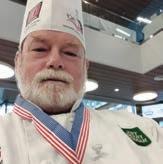

Each month, we highlight a different ingredient in the ACF’s Online Learning Center. Visit the center at acfchefs.org/IOTM to complete a quiz and earn one hour of continuing education credit toward ACF certification and recertification.
The Culinary Insider, ACF’s biweekly newsletter, offers ACF news and links to recent articles, plus information about upcoming events, certification, member discounts, competitions, contests and much more. Sign up at acfchefs.org/tci.
Follow the ACF on your favorite social media platforms:
@acfchefs
@acfchefs
@acf_chefs
@acfchefs
@acf_chefs
American Culinary Federation
Check out ACF’s Online Learning Center. There you’ll find NCR quizzes, videos of educational sessions from ACF events, practice exams for certification and more. Visit learn.acfchefs.org to get started and earn CEHs.
Tag us on Instagram!
When posting your delicious creations on Instagram, tag #ACFChefs or send to @acf_chefs and we’ll repost our favorites here and online!
WORLD'S #1 DRIED FIGS & DRIED APRICOTS PRODUCER


WORLD'S #1 MEDITERRANEAN SEA BASS & SEA BREAM PRODUCER
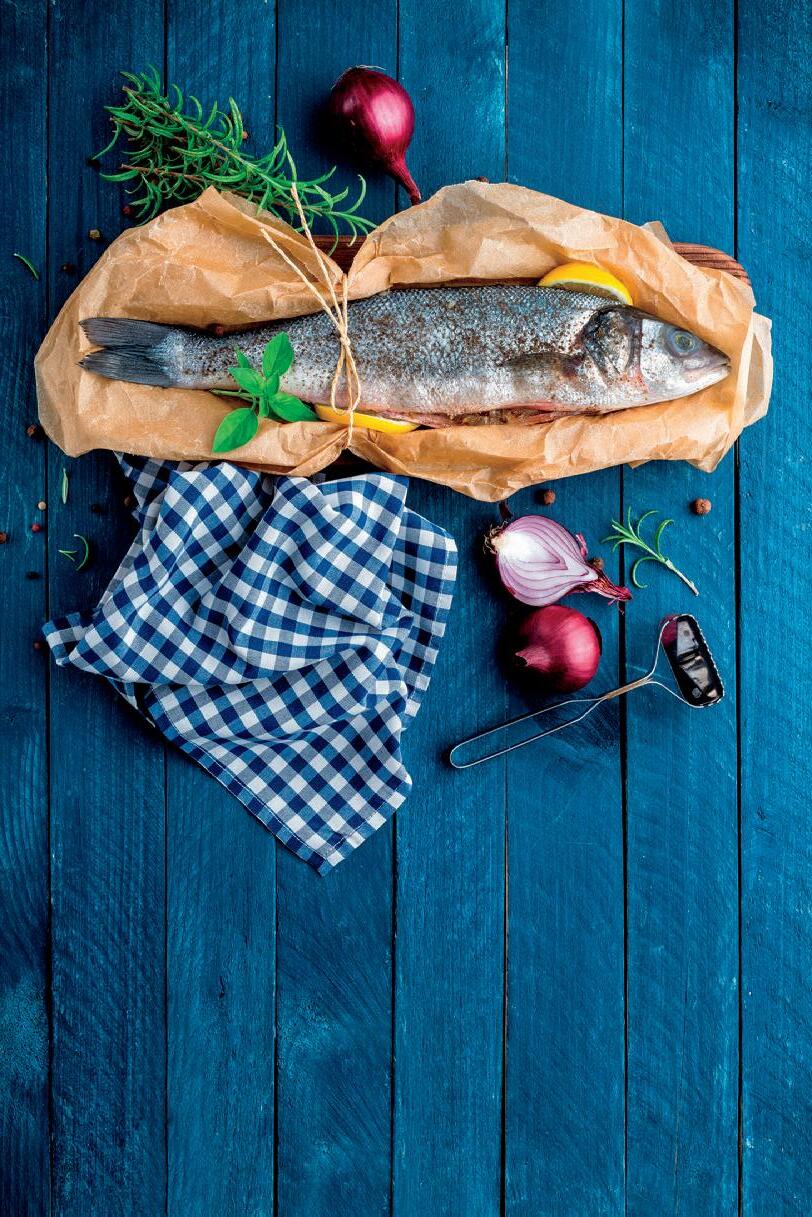
WORLD'S #1 ROSEMARY, OREGANO, BAY LEAVES, SUMAC, ALEPPO PEPPER PRODUCER

WORLD'S #3 TABLE OLIVES & OLIVE OIL PRODUCER
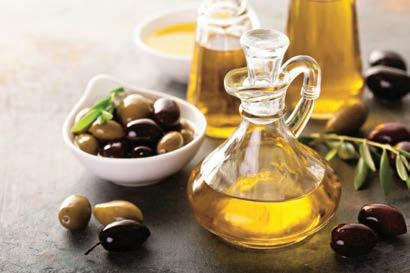
WORLD'S #2 PASTA, #1 BULGUR, #3 LENTILS PRODUCER


WORLD'S #2 TOMATO & PEPPER PRODUCTS MANUFACTURER


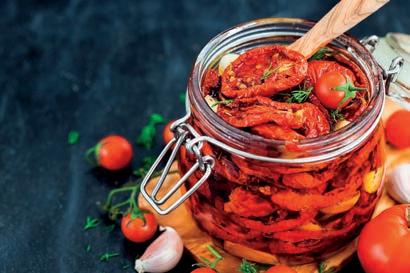
In March, qualifier competitions for ACF National Competitions awards were held at Johnson County Community College in Overland Park, Kansas.
Here is the list of regional award winners:
Chef of the Year
• Central – Russel Cunningham, CEC, AAC
• Northeast – Tony Le, CEC
• Southeast – Paul Jensen, CEC, CCA, AAC
• Western – Tom Tobin, CEC
Pastry Chef of the Year
• Central – Lauren Aleman
• Southeast – Chrissy Jensen, CEPC
• Western – Rebecca Freeman, CEPC (there were no applicants for the Northeast region)
Student Chef of the Year
• Central – Jennie Huynh
• Northeast – Maxwell Smith
• Southeast – Roman Nourse
• Western – Andrea Sanchez
Student Pastry Chef of the Year
• Central – Margaret Waddle
• Northeast – Vanessa Ruiz, CFPC
• Southeast – Patricia Santibanez
• Western – Kambree Thomas
Student Team of the Year
• Central – Joliet Junior College
• Northeast – Culinary Institute of New York at Monroe College
• Southeast – Asheville-Buncombe Technical Community College
• Western – Navajo Technical University
Here are the finalists from the qualifier competitions who will advance to the ACF National Competitions in these categories at convention:
Chef of the Year
• R ussel Cunningham, CEC, AAC
• Chad Burnett, CEC
• Tony Le, CEC
• Paul Jensen, CEC, CCA, AAC
Pastry Chef of the Year
• L auren Aleman
• Donna Mallett, CPC
• Chrissy Jensen, CEPC
• R ebecca Freeman, CEPC
Student Chef of the Year
• Jennie Huynh
• Caitlin Drzyzga
• Maxwell Smith
• R oman Nourse
• A ndrea Sanchez
Student Pastry Chef of the Year
• Margaret Waddle
• Vanessa Ruiz, CFPC
• K ambree Thomas
• Shawnti Diaz
Student Team of the Year
• Joliet Junior College
• Metropolitan Community College Institute for the Culinary Arts
• Culinary Institute of New York at Monroe College
• A sheville Buncombe Technical Community College
Here are the finalists for the Chef Educator of the Year competition:
• Ryan Binney, CEPC, CCE
• Michael Stamets, CEC
• R obert Zehnder, CEC, CCE
Here are the finalists from the 47th Joint Culinary Competition, held at the Joint Culinary Training Center in Fort Lee, Virginia, Feb. 28 – March 11, who will advance to ACF National Competitions in these categories:

• Chef of the Year – R SCPO Michael Edwards, U.S. Navy
• Pastry Chef of the Year – E PO1 Mariam Bingham, U.S. Coast Guard
• Student Chef of the Year – Cpl. Carol DuenezVallejo, U.S. Marines Corps
• Student Pastry Chef of the Year – Lt. Cpl. Ashley Diaz-Araujo, U.S. Marines Corps
Here are the ACF Chapter of the Year regional award winners (national winner to be announced at convention):
• ACF West Michigan Lakeshore Chapter
• ACF Cleveland Chapter
• ACF Atlanta Chefs Association
Here are the Hermann G. Rusch Chef’s Achievement Award regional winners (national winner to be announced at convention):
• Central – Patrick Mitchell, CEC, AAC
• Northeast – John DiSessa, CEC, AAC
• Western – Carlton Brooks, CEPC, CCE, AAC (there were no applicants for the Southeast region)
Here are the Dr. L.J. Minor Chef Professionalism Award regional winners (national winner to be announced at convention):
• Central – James Kremer, CEC, AAC
• Northeast Region – Fernando Mojica, Jr., CEC
• Southeast Region – Charles Wilson, CEC, PCEC, CCA, AAC
• Western Region – John Casto, III, CEC
ACF President Kimberly Brock Brown, CEPC, CCA, AAC, was invited by the U.S. Department of State to be an advisor member of a newly formed Kitchen Cabinet, part of a Diplomatic Culinary Partnership with the James Beard Foundation. ACF Young Chefs designed some of the menu items and prepared and served their creations at the event. The ACF student members in attendance were also each personally recognized by U.S. Secretary of State Antony Blinken during his speech for representing the future of the culinary industry.
Congratulations to ACF Chef Andy Chlebana, CMPC, CCA , professor of culinary arts/pastry chef, Joliet Junior College, Jolliet, Illinois, for earning his ACF Certified Master Pastry Chef designation. Special thanks to Virginia Western Community College, Roanoke, Virginia, and its students for graciously hosting the exam, as well as to the candidates, evaluators and subject-matter experts for their support and dedication in moving the CMPC forward.
ACF Chef Kevin Mitchell received the Outstanding Hospitality Educator Award from the South Carolina Restaurant and Lodging Association at the association’s Stars of the Industry gala.
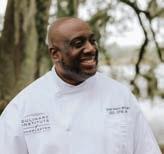

Launched earlier this year, the ACF Sustainability Corner offers tools to help educate you, your team and students on sustainable concepts to help minimize cost while reducing your carbon footprint. Members can earn two CEHs by completing the quiz on the Online Learning Center. This month’s topic is Air, Water and Plastic Pollution. Visit acfchefs.org/sustainability to learn more.
ACF Chef Nicholas Mercogliano, CEC, CPC, corporate executive chef at Pecinka Ferri Associates, a manufacturer’s agent representing foodservice equipment, was recently promoted to partner.


ACF Chef Brian Peffley, CEPC, CCE, AAC, a pastry chef and instructor at the Lebanon County Career and Technology Center in Lebanon, Pennsylvania, was named the 2023 Pennsylvania ProStart Educator of the Year at an awards ceremony on March 1 in conjunction with the ninth annual PA ProStart Student Invitational in State College, Pennsylvania.
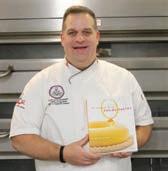
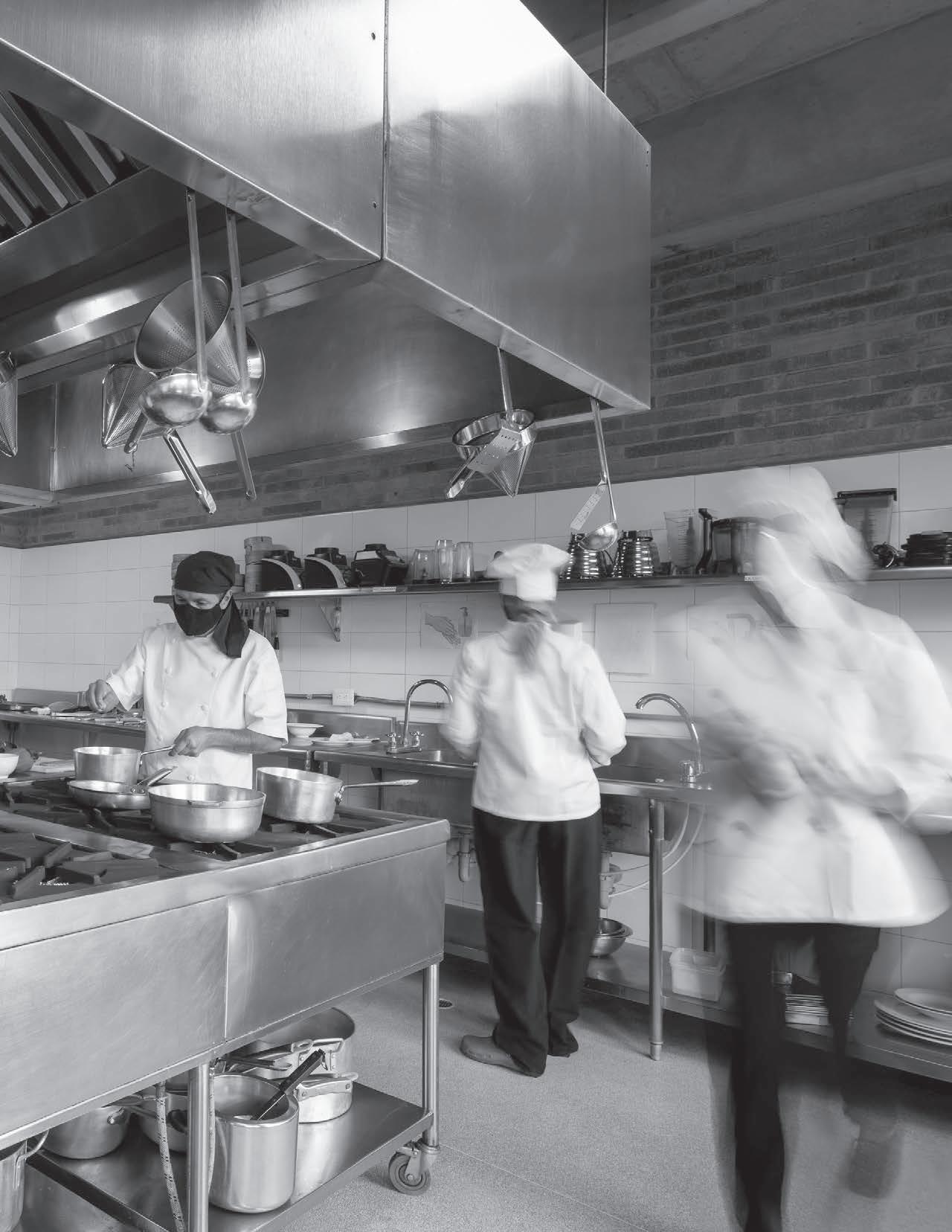
You can’t manage what you can’t see, the saying goes, and thieves hide their handiwork. That is what makes managing a restaurant’s internal security so dicey.
From deliveries and inventory to pilferage of food or equipment and bar operations, operators need a sharp eye — as well as policies and procedures to discourage even the most dedicated thief (as unfortunate as it sounds to say that).
Chef John Franke, founder and president of Franke Culinary Consulting, LLC, in Lantana, Texas, says he dealt with security/theft issues earlier in his career as a corporate chef.
“My focus was mainly working with positioning cameras and how to manage gracefully through those cameras, implementing end-of-the-night protein counts to ensure things aren't walking out of the building,” he recalls. Another goal was building “a culture that lends itself to everyone working together as one team with one dream to ensure buy-in — and working together to hold each other accountable.”
From his perspective, Chef Franke says kitchen operations need three things to operate well: people, product and systems. “The greatest security threat within those three would be the people,” he says. “Product doesn't steal itself. However, the wrong systems in place could in fact play a factor in theft.”
Delivery drivers and all the various personnel walking in and out of the kitchen could certainly be a factor, Chef Franke says, “but primarily in my experience it would be employees. Sometimes it is simple naivete of the employee as to what they can and cannot eat, but other times it’s outright flagrant theft of various foods, beverages or even equipment.”
Deliveries create what Chef Tracy Zimmermann , assistant professor of hospitality management at New York City College of Technology in Brooklyn, New York, calls “a large issue if there is not a standard person receiving with the time and knowledge to check the product.” Product needs to be tracked from ordering and through receiving to utilization. “If not tracked, pilferage or waste could be a great issue,” she says.
Product has to be received and accurately documented as inventory, with correct cost and retail markups assigned. “If a product is not counted or recorded correctly, it causes an error in accounting and potential loss on paper,” says Chris McGoey, owner of McGoey Security Consulting in Jonesborough, Tennessee. “The product can be shorted by dishonest delivery drivers but reported as delivered, causing an instant loss on the books.” Ingredients and supplies can be stolen by dishonest employees at the point of delivery or daily, causing a loss of inventory and increasing the cost of goods.
When it comes to inventory, Chef Franke recalls seeing people pad records to ensure they hit food cost, “which in turn is theft as they are getting bonuses on a number that isn’t reality.” The issue, he feels, is that “you eventually run out of margin on that, and it will blow up on you.” One solution is to have various people at different levels do the counting and others the inputting. “Never give the final food-cost number directly after the counts are inputted, otherwise that system could be fraught with problems,” he says.
Other areas require just as much scrutiny. The bar, according to Chef Franke, is “a whole other beast, and the opportunities to steal are everywhere.” Ingredients can be purposely miscounted, drinks can be “neglected to be rung in. Friends of the bartenders will at times get free drinks, and overpouring/waste making things wrong” can prove a daily struggle.
Solid systems must be in place. For instance, insist that all drinks be rung in before making and/ or serving them. Cameras should be positioned correctly and in working order. Nightly inventory counts should be matched with the POS sales and spill sheets. Instilling consistency in portioning is also critical.
As for theft in waste removal, Chef Franke says, “If a person that pulls the dumpsters has access to the back dock and you have things stored there, that is just asking for opportunities to steal.”

The keys to strong internal restaurant security are policy, procedure and training, says J. Patrick Murphy, president of LPT Security Consulting in Tomball, Texas. “Every restaurant faces variations on a theme regarding shrinkage, so it is incumbent on the company to first create an overall operations policy.”
Hiring factors into this. “Checking references of past employment, giving new employees a full understanding of the strategies in place to avoid theft, asking them situational questions like, ‘What would you do if you saw a fellow employee steal?’ and talking to them about the culture and feeling them out as to whether or not they fit in will all help,” Chef Franke says.
The question “is really about restaurant profit and loss prevention, not security or safety,” McGoey says. “The loss-prevention formula is simple to define and express. The day-to-day application of strict lossprevention policies is a challenge.”

Everything in operations needs a written policy to ensure consistency, Murphy says. “The theory, obviously, is that over time, weaknesses in operations have been discovered and policies changed to meet the weakness.”
“What is the company’s policy on the receipt of anything?” he asks. “Who can check it in? What paperwork must be kept? How are delivered goods’ shortages accounted for? This is all paperwork, but absolute operating procedures reduce the opportunity for theft and error. Operators have to manage people and processes, nothing more. Without a written framework, it is a guaranteed fail.”
Restaurants typically are watchful of their cost of goods, Murphy says. “That is a controllable expense. But is that dollar amount being compared to revenue to see if sales are as forecasted while the cost of goods continues to rise? You may not catch it in one month, but it’s an Excel spreadsheet put to a graph. At least management is getting a view from 25,000 feet, and they can filter it down by line item. It’s a deep dive into the paperwork and not about cameras. Cameras are great when someone slips on a greasy floor and you have video. But detecting a theft on video? Not so much.”
Says Chef Franke, “People are people, and it's our responsibility as leaders to set the systems in place, hire the right people, create a culture of togetherness and buy-in and trust those under us while still verifying their activities. Theft will happen, but with the proper culture and team building, much of it can be alleviated.”
The height of the COVID-19 pandemic certainly wasn’t the most opportune of times to start a new ACF chapter. It may actually have been the worst of all possible times, given the limits on indoor dining and the ensuing labor and supply chain challenges.
Yet, two years ago, in June of 2021, ACF Chefs Brian Tatsukawa, CEC, Robert Witte, CEC, CCA, AAC, and their colleagues formed the Four Corners ACF chapter, encompassing the state of New Mexico and portions of the adjacent states of Arizona, Colorado and Utah. Its motto, “providing a culinary cornerstone in the Four Corners area,” reflects the mission and strategic intent of the chapter.
“Yes, it was a tough time to start a chapter, but, in some respects, we were pretty fortunate,” says Chef Tatsukawa, a culinary instructor (along with Chef Witte) at the ACF-accredited (exemplary status) Navajo Technical University in Crownpoint, New Mexico, and a 2022 recipient of ACF’s Cutting Edge Award. “There really wasn’t a local chapter that served our specific geographic area, so we launched the chapter. It just made more sense for us to start a new chapter than to try to fit into one too distant from us.”
Originally launched with 23 members, the membership is now growing. “Some local students have joined, as well as students from our college,” Chef Tatsukawa says. “COVID hit culinary programs in colleges hard — in fact, we were down to only a few students at the university in the program at one point, but we have bounced back.
We have up to about 15 students this semester in our primary cooking classes.”
Despite its relatively short time as an ACF chapter, the Four Corners chapter is vibrant with activities and community involvement.
“We’ve done demonstrations for our local Native American youth; we’ve held some classes on how to make Kung Pao chicken and fried rice. Our advanced baking instructor did a cupcake decorating class, and we’ve also worked with Sysco, having new product demonstrations,” Chef Tatsukawa says. “We take pride in our educational programs. We’ve also joined with the local Rotary Club to raise money for scholarships for high school students.”
Chef Tatsukawa says that one of the most impactful — and emotional — programs that the chapter hopes to assist with this year is a “Shop with a Cop” program involving law enforcement personnel. “Shop with a Cop” is a national program held during the December holiday season when police officers shop with children in need for gifts, toys and a much-needed boost of joy.
“We’re always trying to reach out and do local programs, and that’s one that we really hope to connect with,” Chef Tatsukawa says. “It’s heartbreaking to hear what the kids from broken homes and orphanages go through. My wife is a participant in the program and some of the stories the children had shared with her were heartbreaking. Some of the children were choosing food over gifts,
and others were forced to make more difficult decisions.” Four Corners chapter members are hopeful that they can raise funds, cook meals and/or source volunteers to help out.
In addition to philanthropy and civic activities, competitions and convention involvement are becoming other cornerstones of the Four Corners chapter.
Chef Tatsukawa is currently prepping a student team for an ACF regional competition, and chapter members will also be participating at the ACF National Convention. “We will have some of our chapter members presenting and cooking

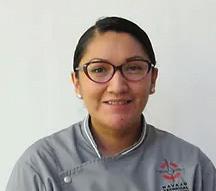


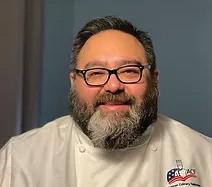
Native American frybread,” he says.
The chapter meets in person or Zoom every other month, “but the bulk of our members come from the Crownpoint (New Mexico) area, so it’s not too difficult to get everyone in attendance,” says Chef Tatsukawa.
Chef Tatsukawa is upbeat about the future of the chapter and is looking forward to its continued growth and progress. “We have a strong nucleus of chefs who are dedicated to the chapter,” he says. “We continue to look forward to growing our membership and becoming even more involved.”
President Chef Brian Tatsukawa, CEC, MBA Chairman of the Board Chef Robert L. Witte, CEC, CCA, AAC Secretary Chef Melvina Jones, CWPC Vice President Chef Walter Cloud, CSC, CWPC Treasurer













 By ACF Chef Jennifer Hill Booker
By ACF Chef Jennifer Hill Booker
Juneteenth is the oldest nationally celebrated holiday marking the ending of slavery in the United States. From its Galveston, Texas, origin in 1865, the commemoration of June 19 as the African American Emancipation Day has spread across the country. Juneteenth officially became a federal holiday in 2021.
I first learned about Juneteenth and its history when I moved to Tulsa, Oklahoma, in high school. We always celebrated the day with festivities on the north side of town. For those of you not familiar with Juneteenth’s history, let me share with you a brief overview.
As stated in the U.S. National Archives, “President Abraham Lincoln issued the Emancipation Proclamation on January 1, 1863, as the nation approached
its third year of bloody civil war. The proclamation declared ‘that all persons held as slaves’ within the rebellious states ‘are, and henceforward shall be free.’”
Published reports indicate that slaveowners withheld news of the enslaved peoples’ emancipation, however, and it was more than two years after Lincoln signed the Emancipation Proclamation that slaves in Galveston, Texas, finally received word on June 19 that they were free. For the first time, these Texas slaves were recognized as American citizens. What followed was a celebration encompassing the joy felt at being freed of their bondage. Much of this joy was shown through cooking and sharing food with family and friends. Fast forward more than 150 years, and food still plays an important part of Juneteenth celebrations. I asked several of my chef friends what Juneteenth means to them.
Chef Maurietta Amos, culinary arts instructor at Atlanta College and Career Academy, says she was unaware about Juneteenth until she was a grown woman. “Growing up as a minority in a small predominantly white Midwestern town, the Black parents in our community were very intentional in making
sure all of the kids were exposed to African American history and culture year-round,” she says. “I thought I knew everything there was to know about African American history and our pioneers. I even knew about ‘Black Wall Street.’ I was very surprised to learn about Juneteenth as a grown woman. I was shocked to learn the significance of Juneteenth and how important it was to celebrate it. Juneteenth put into perspective the tenacity and faith that exists within the African American community.”
Chef Amos says that her family has become more conscious of celebrating the true meaning of family, and as a chef, food is always at the center of all of their celebrations. “Growing up, I remember one of my grandparents had chickens and roosters in the backyard — we ate a lot of chicken. What I love about chicken dishes is the versatility and the ease in which they can be prepared and take on different versions by changing up a few ingredients.
My Herb-Roasted Spatchcocked Chicken recipe is a go-to when my family gets together on Juneteenth and at other times of the year and represents how important family and food is to me.”
Chef Deborah VanTrece, founder and CEO of the VanTrece Hospitality Group, says, “Juneteenth for me is akin to a family reunion. Friends and family gather together to celebrate each other and our ancestors. I was born in Kansas City, so of course, my favorite food for Juneteenth is barbecue.
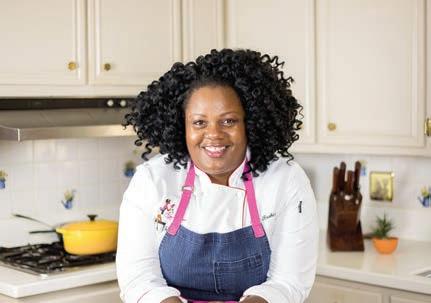

Recipe by Jennifer Hill Booker
Yield: 4 drinks
Ingredients:
24 ounces hibiscus lemonade
8 ounces simple syrup
4 ounces freshly squeezed lime juice
Crushed ice
8 ounces club soda
4 lime wedges
Directions:
1. Combine the hibiscus lemonade, simple syrup and lime juice in a pitcher. Stir to combine.
2. Pour into tall glasses filled with crushed ice, top with club soda and garnish with a lime wedge.
3. Enjoy!


Smoked and glazed with red mopping sauce, and served with red drink, it is a tradition I continue to uphold.”
Chefs Kenny Gilbert and Darren Thompson would agree that food and festivities go hand-in-hand on Juneteenth. These African American chefs celebrate Juneteenth with friends, family and their favorite recipes. For Chef Gilbert, author of the recently released cookbook “Southern Cooking, Global Flavors,” that would be his dad’s ribs, his mom’s coleslaw and his grandma’s sweet potato pie. “These three people are the strongest influences in my life, and I credit their struggles for giving me the motivation to be the chef and restaurateur that I am today,” he says.
Chef Thompson, executive sous chef at Stab’s Prime Steak and Seafood in Baton Rouge, Louisiana, also believes that family is what makes Juneteenth special. His grandmother’s “Swangin’ Steaks” recipe is a family favorite that speaks to a time before slaves were freed and were forced to cook with whatever scraps they could find. “These chefs would cook dishes based on their family
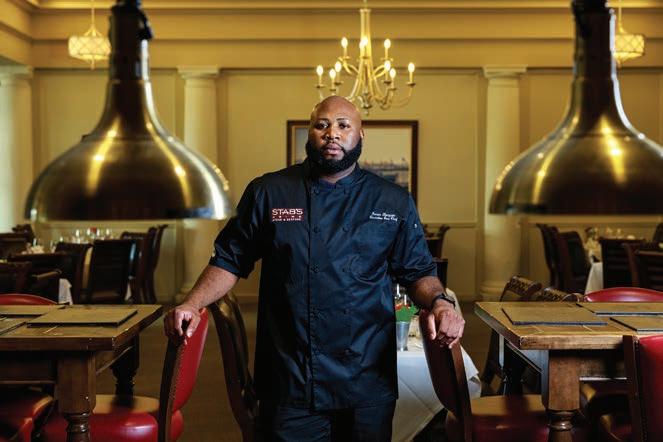
traditions and food memories, which makes me wonder, what foods were prepared by the new American citizens, celebrating their freedom from slavery?” he says.
Several historians and archived reports from the National Museum of African American History and Culture suggest it would have been crops like watermelon that were still in the fields when slaves were emancipated. Others say celebratory dishes like black eyed peas and greens would have been served, symbolizing good luck; or communal dishes like barbecue, gumbo or pots of beans. And you can’t talk about Juneteenth foods without talking about the color red. This crimson color has great spiritual meaning with many African tribes, whose members were brought to America and enslaved.
West African slaves brought with them the kola nut and bissap or hibiscus plant. Both the seeds from the kola plant and petals from bissap flowers were steeped in hot water to produce the red drinks kola nut tea and hibiscus tea. Both of these drinks are still enjoyed today. Red is not limited to Juneteenth drinks, but can be found in sweets like red velvet cake and in savory dishes like hot links, barbecue and hot sauces. Whether you celebrate Juneteenth with red drinks, barbecue or sweet potato pie, there is no denying the very important role Juneteenth continues to play in both our civil and culinary history.
Chef Darren Thompson is an African American chef and native of Orlando, Florida. He is currently the executive sous chef at Stab’s Prime Steak and Seafood in Baton Rouge, Louisiana. This Juneteenth recipe sheds light on those unfavorable cuts of meat that our ancestors were given from their masters. “The oxtail has always been a delicacy in my family’s home,” he says. “My grandmother would call them ‘swangin steaks,’ and that’s just what they are!”
Yield: Serves 9-12
Ingredients:
3 pounds beef oxtails
3 teaspoons kosher salt
2 teaspoons freshly ground black pepper
3 tablespoons Worcestershire sauce
















1 1/4 cups all-purpose flour
3/4 cup vegetable oil
2 large yellow onions, diced
3 stalks celery, diced
2 carrots, diced
1 tomato, diced
5 cloves garlic
5 cups beef broth
2 sprigs fresh thyme
1 bay leaf
Method:
1. Season the oxtails with salt and pepper. Drizzle the Worcestershire sauce all over the oxtails, then toss the oxtails to make sure that they are coated.
2. Dredge oxtails in flour. Shake off excess and set flour aside.
3. Heat oil in a Dutch oven or large ovenproof pot over medium-high heat. Add the oxtails and cook until browned, flipping once, about 10 minutes.
4. Remove oxtails from pot with a slotted spoon, leaving drippings in the pot. Add the onions, celery and carrots and cook until soft and translucent. Add the garlic and tomatoes and cook just until garlic is fragrant. Reduce heat to low.
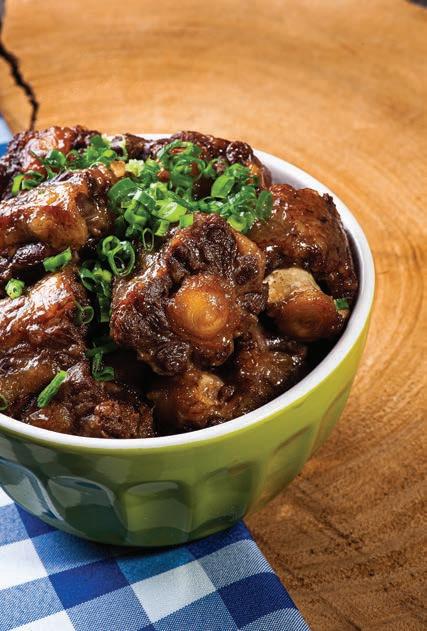
5. Add remaining flour, whisking continuously to create a roux. Cook until roux is medium-golden brown.
6. Slowly add beef broth while continuously whisking. Add oxtails back to the pot, along with the thyme sprigs and bay leaf.
7. Bring liquid to a simmer and cook until meat is tender and falls off the bone, about 3 1/2 hours.
8. Season to taste with salt and pepper. Place oxtails on a large platter. If gravy needs thickening, bring to high and cook until reduced by 1/3. Spoon gravy over oxtails and serve warm.
 Recipe by Chef Maurietta Amos
Recipe by Chef Maurietta Amos
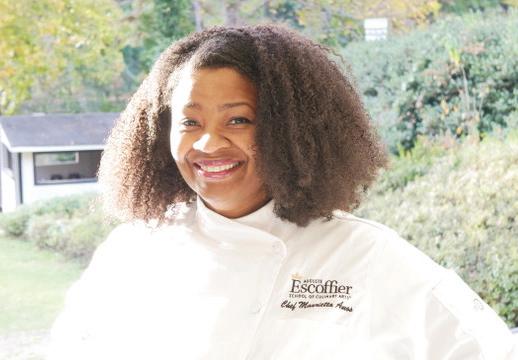

























Yield: 4 servings
Ingredients for the Chicken:
1 whole fryer chicken (approximately 3.5 lbs.)
2 tablespoons olive oil
2 tablespoons melted unsalted butter
2 teaspoons fresh rosemary, finely chopped
1 teaspoon marjoram, finely chopped
2 teaspoons flat-leaf parsley, finely chopped, divided
1 teaspoon fresh thyme, finely chopped
1 to 2 garlic cloves, minced (about 1 teaspoon)
1 teaspoon kosher or sea salt
1/4 teaspoon freshly ground black pepper
1 navel orange, thinly sliced
1 Meyer lemon, thinly sliced
1/2 cup unsalted chicken stock
Ingredients for the Paprika-Dusted Potatoes:
1 1/2 pounds assorted potatoes (red and Yukon gold), cut into large cubes with the skin on, rinsed
2 tablespoons olive oil
3/4 teaspoon kosher salt
1/2 teaspoon freshly ground black pepper
1 tablespoon smoked paprika
1 small shallot, minced
2 garlic cloves, minced
2 tablespoons minced herbs (parsley and rosemary)
Method for the Chicken:
1. Using kitchen/poultry shears, remove the back bone from the chicken by cutting alongside the bone on either side. Place the chicken on a cutting board, breast side up and press on the center breast bone to flatten.
2. Pat chicken dry on all sides. Place on a sheet pan and refrigerate, uncovered, for 30 minutes.
3. Preheat oven to 425° F (conventional) or 400° F (convection).
4. Combine oil, melted butter, rosemary, marjoram, 1/2 of the parsley, thyme, garlic, salt and pepper.
5. Remove chicken from the refrigerator and loosen skin. Gently rub the oil-herb mixture all over the chicken and under the skin where loosened. Place chicken, breast side up, on a roasting pan. Place the orange and lemon slices on top and around the chicken on the rack.
6. Roast chicken until skin is golden brown, about 10 minutes. Reduce heat to 375° F. Pour chicken stock into pan. Cover loosely with aluminum foil and continue to roast for 30 to 35 minutes more until the juices run clear and a meat thermometer inserted in the thickest part reads 160° F.
7. Remove chicken from oven and let rest at least 10 minutes before serving. Sprinkle remaining parsley over the top of each breast and serve with the paprika-dusted potatoes.
Method for the Paprika-Dusted Potatoes:
1. Preheat the oven to 350° F. Line a sheet pan with foil that has been lightly sprayed with cooking spray.
2. Bring 1 gallon of salted water to a boil. Add potatoes and maintain a boil for 1 minute. Drain the potatoes into a large bowl. Toss potatoes with the olive oil and herbs. Spread into a single layer on a sheet pan.
3. Roast potatoes until tender and slightly browned, about 25 minutes, tossing a few times during the cooking process.
*Chef’s notes: The leftover drippings can be strained to create a pan gravy. If using dried herbs in place of fresh, reduce the amount called for by 1/2 the amount for each.
Chef Maurietta Amos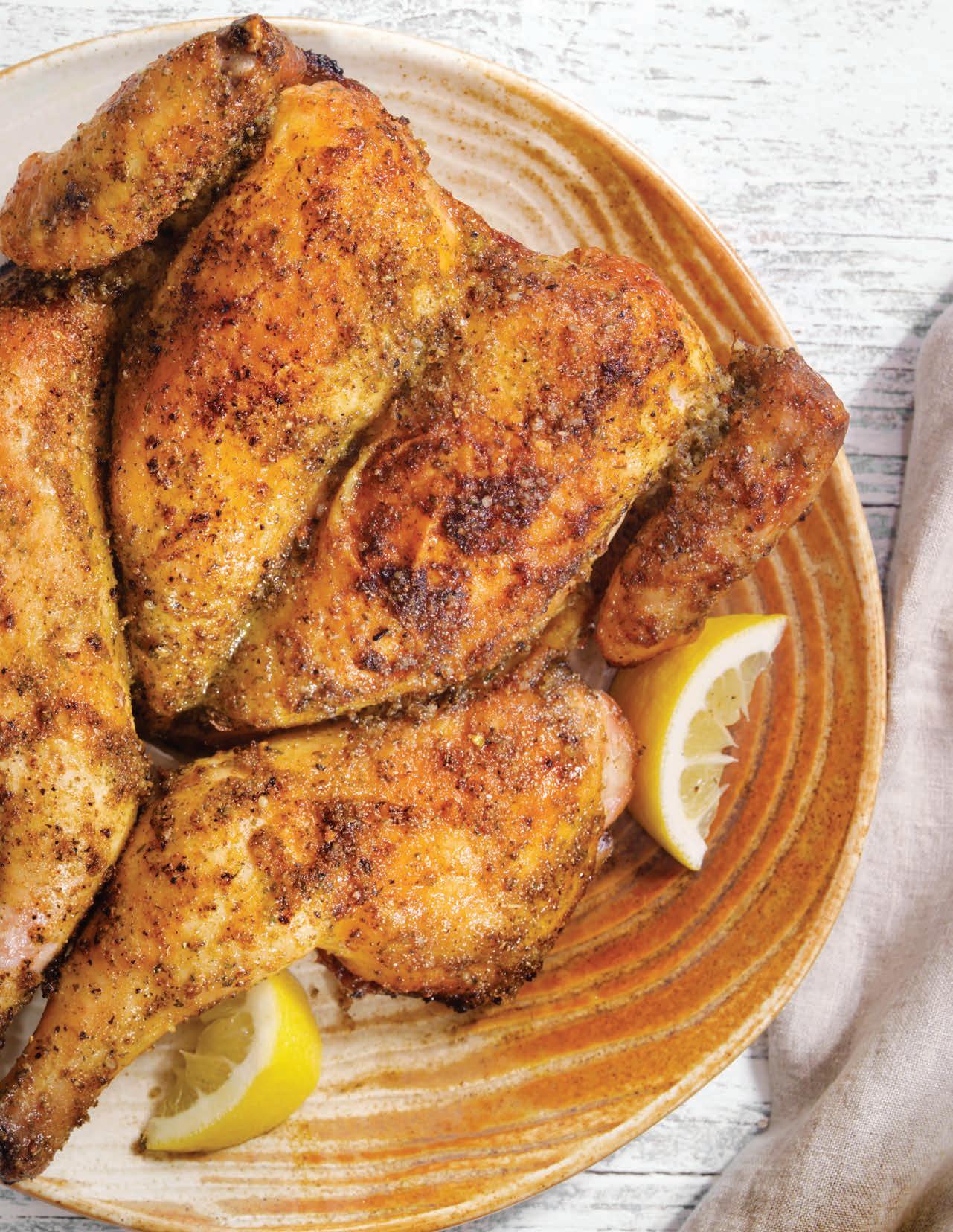

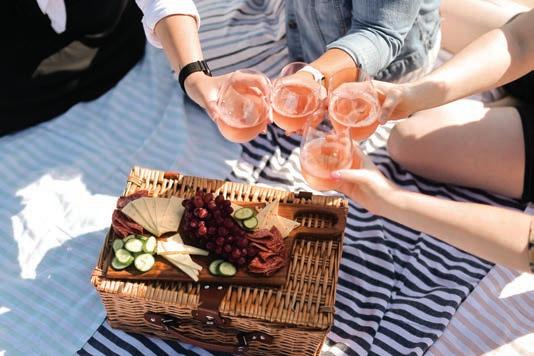

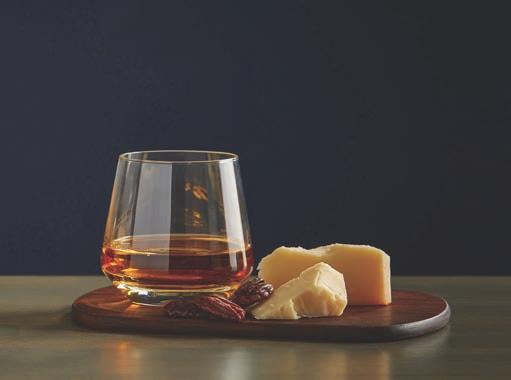


Wine and cheese is a well-known pairing, loved by many, but tasty dairy products can also be paired with cocktails to great effect.
Indeed, Molly Browne, a certified cheese sensory evaluator and education director with the Dairy Farmers of Wisconsin, has developed a program pairing the two ingredients.
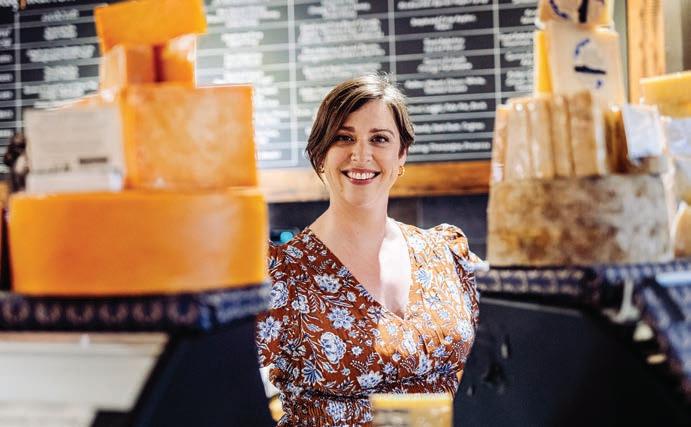
To find the perfect companions, Browne always starts with the cheese, tasting it and evaluating it “and letting it reveal itself to me in layers,” she says. “I let the tasting notes evolve, then think about the next thing I want to put in my mouth.”
The general rule for pairing, Browne points out, is “you want to match intensities.” She suggests matching a light, fresh style of cheese, like burrata or ricotta, with a lighter, gin-based cocktail that's aromatic, “or those mild lactic flavors will get overwhelmed.”
A cheese like an aged cheddar or cave-aged gouda needs a robust drink. “If you pair that with something too light, that flavor is going to get lost,” she says. “You want a balance between both items that enhances both of them. The whole is better than the sum of both parts.”
Here are Browne’s favorite Wisconsin cheese and cocktail pairings:
Gran Canaria (from Carr Valley Cheese) + Mezcal
Negroni
The smoky notes of mezcal are a nice foil for this “meaty” cheese, says Browne, “and the aromatic and bitter notes imparted by the other cocktail ingredients heighten the experience.”
This cheese is made from a blend of sheep, goat and cow milks, creating “a deeply savory, umami-driven profile,” she says.
“This drink is a bit lighter than you might think with a traditional blue cheese,” Browne says,“but this cheese is really creamy and pairs well with the juniper, while the lime juice cuts through the butter fat and keeps your palate fresh.”
The buttery sweetness of this cheese plays exceptionally well with the almond notes in this classic cocktail, says Browne. “You want to play with a lighter flavor in your cocktail to let the mild flavor of the cheese come through." The sour from the citrus raises the whole profile, she points out. “Acidity works like salt and amplifies flavors that are already there.”
“Super-aged cheddars develop powerful flavors, so they need a big cocktail to match the intensity,” explains Browne. “This cocktail tops a basic whiskey sour with a red wine float, giving it depth of flavor that allows it to stand up to something robust.”
Fenugreek adds a maple-like flavor to this young gouda, and these flavors “are rounded out by the coffee notes of the white Russian,” says Browne.
This duo works just as well as wine to bring interest to food and beverage menus //
By Amanda BaltazarMolly Browne, a certified cheese sensory evaluator and education director with the Dairy Farmers of Wisconsin, enjoys teaching others about cocktail and cheese pairings.
A classic paella , cooked outside on the grill, is a favorite of ACF Chef Robert Marilla, CEC, AAC, culinary arts department chair, Central Piedmont Community College in Charlotte, North Carolina, especially when vacationing during the summer along North Carolina’s beaches. “We’ll go down to the docks to get fresh seafood — red snapper, flounder, shrimp, clams,” he says. When preparing paella for the grill, it’s simple. Put everything, rice and all, in a paella pan, “stir it initially just to incorporate everything, then leave it alone for 20 to 22 minutes.” Back home, which is three and a half hours inland from the coast, he’ll often do a land-based version with chicken, rabbit and/or duck.
For a modern take on paella , Chef Marilla goes with a deconstructed approach, cooking the elements of the dish separately and elegantly plating them together. He cooks the Spanish Calasparra rice risotto-style with onions, adding stock a little at a time. Instead of just adding peas, he prepares a pea and green onion puree by simply boiling the vegetables in water and adding butter, salt and pepper. The “overnight tomato” is a halved Roma tomato seasoned with salt, pepper, garlic, parsley, thyme and olive oil and left in a gas oven overnight with just the pilot light on so it’s just gently dehydrated “without the forced air.” Clams and mussels are cooked together in white wine, garlic and shallots, and that liquid is later reduced into a sauce with some added butter and parsley. For the grand finale, soft-shell crab, which is in season in May, gets a light dusting of fine white cornmeal mixed with paprika and other herbs for a quick pan-fry.

For recipes, visit wearechefs.com
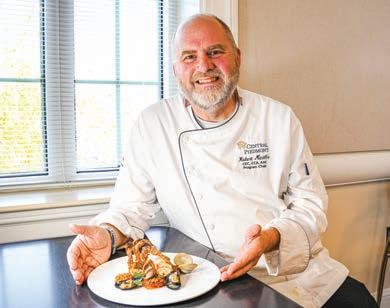

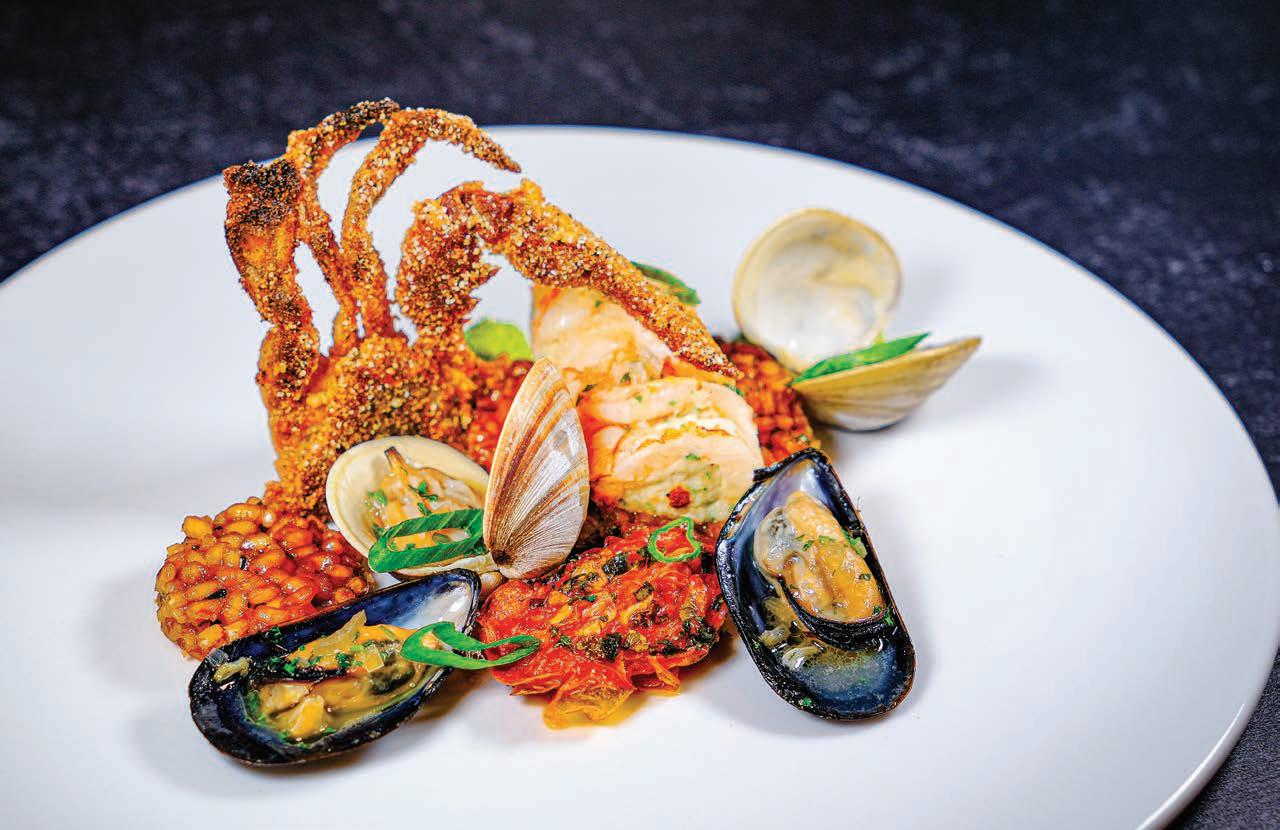
 Photo credits: Eli Schopp
Photo credits: Eli Schopp

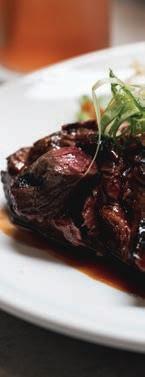


The culinary flavors and traditions of the Aloha State took their time blossoming into a defined regional cuisine. Today, Hawaii is a food destination for locals and travelers alike.


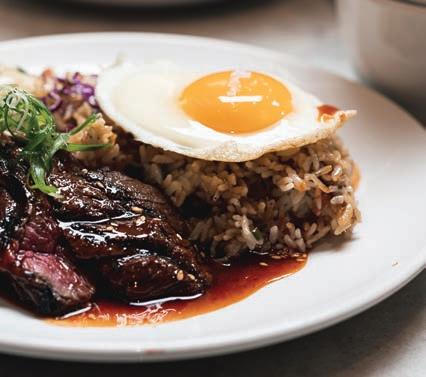
The idea of Hawaiian cuisine as a regional American cuisine premiered in the 1980s when ACF Chef Peter Merriman was working his way up to executive chef of Mauna Lani Resort’s Gallery Restaurant on Hawaii’s Big Island. Chef Merriman, a member of the ACF Kona Kohala Chefs Association, says he was determined to label his fare regional cuisine, but it wasn’t so easy at first; there were no established relationships between chefs and local producers of produce, meat and fish. “When I came, restaurants were just doing their interpretations of local dishes, like lobster teriyaki, in an upscale manner,” Chef Merriman says.
In 1988, he opened his flagship restaurant, Merriman’s Waimea, on the same island while developing relationships with about a dozen other renowned chefs across Hawaii who had similar culinary goals. In 1991, they formed a coalition they called Hawaii Regional Cuisine to build a network of farmers, growers and ranchers from whom they could source local product, benefiting both the chefs and the producers. Chef Merriman served as the first president of this enterprise that set off a food revolution. Today he is chef/owner of ten restaurants throughout the islands. “Over time, as more local products have become available, regional cuisine has come to focus more on locally produced ingredients rather than just techniques from local people,” he says.
As with any authentic regional cuisine, the dishes should reflect the culture. Thus, in Merriman’s view, “The cuisine of Hawaii is about the immigrants.”
With a population of about 1.4 million, fewer than 10% of Hawaii’s residents are native Hawaiian/Pacific Islanders, according to recent census data. In the late 1800s and early 1900s, sugar and pineapple plantation owners recruited workers from such locales as China, Japan, Korea, the Philippines, Puerto Rico and Portugal, says Joan Namkoong , author of “A Korean Kitchen: Traditional Recipes With an Island Twist,” “The Food Lover’s Guide to Honolulu” and other Hawaiian-centric books and retired food editor for the Honolulu Star-Advertiser, the largest daily newspaper in Hawaii. These ethnic groups remain on the islands and make up the majority of the population, which informs the local cuisine.
“Plantation workers shared their foods in the sugar fields over lunch, and everyone adapted to everyone else’s cuisine,” she says. “Hawaii is really a melting pot for cuisines and is the basis for the local food here in Hawaii.”

Namkoong points to saimin, the popular comfort soup of Hawaii. “It’s a noodle dish in broth,” she says. “It typically uses Chinese noodles in Japanese broth. It’s not ramen because it’s a different broth.” The broth is actually a dashi typically made with kombu, dried mushrooms and dried shrimp or bonito and garnished with green onions and kamaboko (fish cake), but it also sometimes features Chinese char siu, Spam, a sliced egg and/or shredded nori.
Poke, one of the most popular Hawaiian breakouts to the mainland, is indigenous to the islands. Poke is a Hawaiian term that means “to cut into small pieces.” Originally poke was made with raw fish, not always tuna, and seasoned with salt, roasted candlenut and seaweed, Namkoong says. The candlenut tree, also known as the kukui tree, is Hawaii’s state tree. Later, with adaptations from other cultures, poke took on such ingredients as soy sauce, sesame oil, chili peppers, onions, wasabi and mayonnaise.
Chef Merriman has his own poke views; namely, he’s not a fan of mayonnaise. “I like the cleaner flavor of fresh fish, because the quality of our fish in Hawaii is so good,” he says. “I like to include ginger, chili

pepper and avocado, keeping it fairly simple so as not to mask the beautiful qualities of fresh fish.”
The sugar plantation lunches of old spawned what is now Hawaii’s iconic plate lunch served in local eateries. In divided-tray fashion, it’s usually two scoops of rice, a protein and macaroni pasta salad, Namkoong describes. The protein could be braised short ribs, fried chicken or teriyaki chicken, for example. “The key is that it’s carb and protein heavy with very little vegetables,” she says. “Sometimes restaurants will substitute green salad in place of mac salad.”
Dishes at high-end restaurants in Hawaii always seem to balance ethnic heritage with island ingredients and modern twists.
Executive Chef/Partner Robynne Maii of Fête in Honolulu serves seasonal New American farm-to-table cuisine. “We want to cook food that is delicious and familiar, but we take creative liberties based on what’s available to us locally,” says Maii, the 2022 James Beard Award winner for Best Chef — Northwest and Pacific and the first woman chef from Hawaii to win. Maii was born and raised on Hawaii’s Big Island. Her grandparents are from Korea, so she grew up eating Hawaiian Korean food. Korean bavette is on the menu at Fête in honor of her heritage. The dish features local grass-fed grilled bavette, gochujang sauce, gingerscallion fried rice, sunny local egg and Asian pear slaw.
Adding a local touch to the restaurant’s spaghetti carbonara, Chef Maii uses a mix of slab bacon and Portuguese sausage. “It’s clearly not authentic, but it’s just as delicious,” she says.
For Chef Maii’s Kauai coconut prawns dish, she fries the black pepper-seasoned prawns in coconut oil, which is indigenous to Hawaii. Toward the end of the cooking time, she adds curry leaves from plants that grow everywhere on the islands. She then finishes with a quick squeeze of local lime and a sprinkling of toasted coconut.
Chef Merriman features smoked taro hummus on the appetizer menu as a way to introduce guests to taro, which is among what he calls canoe crops — items that native Hawaiians brought with them from elsewhere. “Originally there weren’t a lot of food sources on the island because we’re so isolated,” he says. “Bananas, sweet potatoes, taro and wild pig were all brought here in canoes.”
With a myriad of tropical fruits, desserts benefit from a paintbox of flavors combined with cultures. Desserts are Michelle Karr-Ueoka’s specialty as chef/ owner and pastry chef at MW Restaurant in Honolulu. Her own family is a diverse melding of cultures. “I’m Japanese, Danish, Dutch and German,” she says. “My grandfather was from Ireland, and my grandparents are from Japan.”

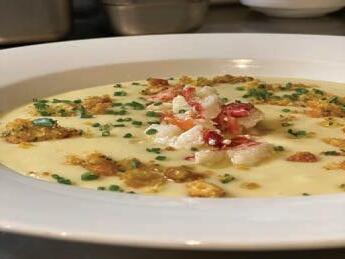
Yield: 2 quarts
Ingredients:
4 ounces canola oil or butter
1 onion, peeled, medium dice, about 12 ounces
• 3 leeks, medium size, whites only, medium dice, washed well
• 3 pieces garlic clove, sliced thin
Shave ice is a dessert every kid in Hawaii grows up with. For Chef KarrUeoka’s signature version, called Makaha mango shave ice, rather than shaving a regular block of ice, she purees fresh mango, freezes it and shaves that. “It’s like making a granité,” she says. She places a layer of panna cotta on bottom followed by tapioca, fresh mango and mango/lemongrass sorbet and then tops it with the shaved mango.
Malasadas are a stand-out dessert in Hawaii thanks to the Portuguese. A malasada is similar to a raised yeast donut hole that is deep fried and rolled in sugar. The Tuesday before Ash Wednesday, heading into Lenten season, is called Malasada
• 8-10 ounces ulu (breadfruit), steamed, peeled, seed removed, medium dice
• 2 teaspoons each salt and pepper
• 1/2 teaspoon fresh ground nutmeg
• 1/2 teaspoon chili pepper flakes
• 1/2 cup dry vermouth
2 quarts chicken or vegetable stock
1 tablespoon lemon juice
• Optional: coconut milk, to taste
Method:
1. In a pot, heat oil/butter. Add onion, leeks, garlic and ulu. Reduce heat to medium and stir. Cook for about 7 minutes.
2. Add salt, pepper, nutmeg and chili pepper flakes. Stir and cook 1 minute.
3. Add vermouth and reduce by half.
4. Add stock and lemon juice. Continue to cook on medium-low. Cook until vegetables are soft, about 10 minutes.
5. Pour soup into blender. Puree on high speed for about 1.5 minutes with lid on tight.
6. Remove from blender. If the soup is too thick, add additional liquid, such as coconut milk. Taste and add additional salt and pepper if needed. Chopped shrimp, chives and croutons can also be used for garnish.
To learn more about ulu (breadfruit), visit WeAreChefs.com
Day among Catholics. “They made malasadas to use up the eggs, butter and lard in the house,” Namkoong says. She points to Honolulu’s Leonard’s Bakery for making the malasada/Lent connection famous in Hawaii by building its business around it.

Mochi is also a common dessert, both in homes and restaurants, not just in Japanese and Chinese circles, but among many other Asian Hawaiians. “There are very specific types we love here in Hawaii,” Chef Maii says. “Butter mochi and chocolate mochi are the most popular.”

While the sticky glutinous rice dessert is typically a pan affair, “once a year around New Year, it is fashioned into balls and stuffed with red bean paste or sweetened peanut butter or chocolate,” she says. Butter mochi often includes the use of evaporated, whole or coconut milk.
For those raised in Hawaii, certain foods stand out as musthaves. Chef Maii notes that Hawaii comfort food resembles comfort food in the mainland South. Mayonnaise-bound salads, molded Jell-O of all flavors, Ambrosia salad and baked goods are examples, she says.
During World War II, canned meats became a staple on tables in Hawaii out of necessity when supplies and shipments
With all of their pageantry, luaus sell the idea of Hawaii to tourists, says ACF Chef Steven Nakata, culinary arts program coordinator at the ACFaccredited Kauai Community College. More than 8.5 million tourists visited the islands in 2022, according to the Hawaii Department of Economic Development & Tourism, making tourism the state’s biggest industry by far.

Students at Kauai Community College learn how to prepare the standard luau dishes, which students serve to visitors who sign up to attend the college’s fine dining lunch. Chef Nakata describes a few of the standard dishes served at luaus throughout the islands.
Kalua pig is a whole pig wrapped in shredded banana stump to lock in moisture, and then wrapped in banana leaves or the
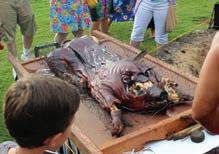
leaves from Hawaiian ti plants, followed by a burlap wrap. The pig is traditionally steamed overnight in an underground imu, or 2- to 4-foot deep pit dug into the ground packed with kindling for fire and rocks on which the food is placed. When it’s done, the tender pork falls off the bone and is shredded.
Lomi lomi salmon is a simple salad of raw salted salmon chunks mixed with tomatoes and onions. Though salmon is not found around the Hawaiian islands, the dish is still popular as tourists are already well familiar with it.
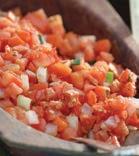
Chicken long rice is actually not rice at all, but mung bean glass noodles combined with chicken and flavored with ginger.
Poi, a Polynesian side dish, is made from taro, a staple crop of Hawaii. Poi may be the most-talked about but least-favorite item on luau menus to the untrained palate, Chef Nakata says. The taro is typically steamed alongside the pig in the imu, then peeled and pounded into a smooth sticky paste.
to the islands were limited. While Spam’s popularity in Hawaii is well known, other canned meats like corned beef, Vienna sausage and canned tuna are equally craved, Namkoong says.


ACF Chef Steven Nakata, culinary arts program coordinator at the ACF-accredited Kauai Community College, calls Spam a lifestyle. Back in plantation days, workers sharing their lunches introduced all their Spam preparations. It was something they could all afford, he says. He proudly embraces Spam as part of his personal diet. “I’ve worked everywhere — France, Italy and South America — in some beautiful hotels, but when I come home, I’m going to have me some Spam,” he says.
For mainland chefs who might like to add a touch of Hawaii to the menu, Chef Nakata offers a simple hack that he employed while heading up food operations at a hotel in Hawaii. “I said, everything on this menu is going to have a Hawaiian name,” so he set out to get the translations. He notes that sea bass sold especially well with the Hawaiian translation Hapu`upu`u. He suggests other chefs could add some Hawaiian vibes to a tropical LTO with the Hawaiian translations.
With the right ingredients, flavors and dish names, you can delight guests with the essence of the Hawaiian tropics.
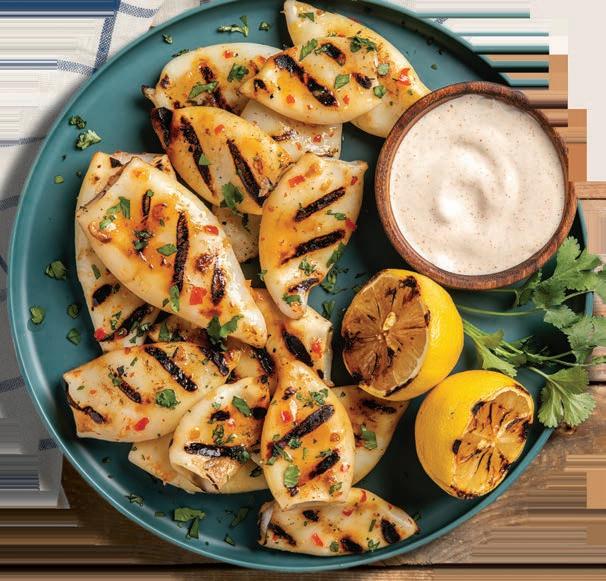

Joan Namkoong, author of “A Korean Kitchen: Traditional Recipes With an Island Twist”
Hawaii is really a melting pot for cuisines and is the basis for the local food here.
Studies show that alcoholism and addictions are on the rise. In an article on substance abuse and the pandemic published in 2021 by the American Psychological Association, University of Washington clinical psychologist and researcher Mandy Owens, Ph.D. , states that she “observed a spike in substance use that includes an increase in both quantity and frequency of drug use.” In 2022, the National Institute of Alcohol Abuse and Alcoholism reported that between 2019 and 2020, alcohol-related deaths jumped 25.5%. If that’s the view of the nation as a whole, the restaurant and hospitality industries offer an even more startling perspective.
The pressures of the pandemic affected everyone, but in the hospitality industry, where substance abuse and alcoholism yield higher numbers than any other industry, a crisis brewed as displaced workers tried to cope with business and job losses, financial struggles and isolation. Managing mental health became a matter of great urgency.
Ben’s Friends, a community of hospitality workers from all segments of the industry, rose to the occasion, using grassroots and other efforts to let their comrades know they were not alone.
Prior to the pandemic, co-founders Steve Palmer and Mickey Bakst strived to meet hospitality workers face-to-face, but the threat of COVID-19 and the need to care for their personal health — physical and mental — prompted them to rethink their efforts. Conferring with BF’s team leaders across the country, they did what many people did and took to the internet to connect with those who had found or were seeking sobriety.
“We’re about acceptance among the like-minded,” says Bakst, who shares a combined 60 years of sobriety with Palmer and just as many years of experience in the hospitality industry. “Our members are owners, chefs, line cooks, servers, front-of-house and back-of-house, sommeliers and bartenders.”
Palmer and Bakst know the pitfalls. They named Ben’s Friends after Palmer’s late friend Ben Murray, who died by suicide in 2016 (the same year BF was founded), after years of struggling with alcoholism. Bakst, who also serves as the nonprofit’s executive director, says Ben’s Friends endeavors to be what he, Palmer, Murray and so many others needed.
“You don’t have to choose between the career you love and sobriety,” Bakst says. “Ben’s Friends helps you maintain sobriety as you continue to build your career in hospitality.”

Charlotte chapter co-team leader Chef Sam Diminich says Ben’s Friends is “a lighthouse and safe space.” A thirdgeneration restaurateur, he witnessed family members struggle with alcoholism, and says he eventually became an alcoholic, too. “Alcohol is the world’s greatest liar,” he says. “Its effects are detached from the realities of the industry, which are both sacrificial and rewarding, when sober.”
During the pandemic, Chef Diminich would stop whatever he was doing to log into daily Zoom meetings. Today, Ben’s Friends offers both virtual and in-person meetings that are open to anyone, whether they are currently sober or just beginning their journey. There are meetings tailored to certain groups (just women, just men, late-night workers, etc.), as well as in-person meeting options in 22 different cities across the country.
Chef Diminich says, “The appeal of BF is that it is grounded in solutions and members have an opportunity to listen and learn from people who know the industry and have viable tools for managing their sobriety, whether they’ve been sober for a year or many years.” The tools Chef Diminich refers to are self-management techniques that sometimes involve pre-thinking a ready response to scenarios liable to trigger a relapse. BF members share something they’ve experienced and the ways in which they protected their sobriety and averted relapse.
Cleveland, Ohio-based family therapist and counselor
Jennifer McClellan Johnson believes organizations like Ben’s Friends are essential and important to sobriety management strategies. “Industry-specific programs are where peers can share the possibilities and can render hope to one another,” she says. “There’s something encouraging about peer support that focuses on best practices for success, especially when combined with other therapies,” which can include individual or group counseling, spiritual or pastoral counseling, behavioral therapy and/or family therapy to name a few.
Bakst is quick to clarify that Ben’s Friends is just one extra layer of support in the fight against alcoholism and addiction.
“Ben’s Friends is not a replacement for AA or NA or a traditional 12-step program,” he says, recognizing that not everyone chooses to participate in such programs. “What we [provide] is an inclusive space for people who need compassion, empathy and a few good suggestions to make it past the next challenge on the path to sobriety.”

ACF maintains a number of strategic partnerships (in addition to Ben’s Friends) with other organizations dedicated to mental health and wellness causes (some are listed below). To support members, the ACF Work/ Life Balance Task Force has compiled a lengthy list of guides, toolkits, websites and other resources to explore. In addition, the ACF ChefsForum Webinar Series has covered mental health topics several times. Visit acfchefs.org to learn more and for links to watch the webinar recordings.
CHOW (chowco.org) stands for Culinary Hospitality Outreach and Wellness and is dedicated to improving the lives of those in our industry through shared stories, skills and resources. Virtual and in-person meetings are available. A CHOW representative will be on site for a morning mental health checkup and meetup each day of the 2023 ACF National Convention.
The Burnt Chef Project (theburntchefproject.com) is a globally recognized nonprofit committed to making the hospitality profession healthier and more sustainable by focusing on people’s wellbeing first. Active Minds (activeminds.org) is a nonprofit supporting mental health awareness and education for young adults, powered by a network of more than 800 high school and college campuses.
Not 9 to 5 (not9to5.org) is a nonprofit committed to mental health advocacy for the foodservice and hospitality sector in the U.S. and Canada.
Restaurant After Hours (restaurantafterhours.org) offers a free virtual support group program via Zoom that is overseen by facilitators trained under mental health counselors who can speak to psychoeducation topics and coping skills. It also has the Restaurant Mental Health Toolkit.
FairKitchens (fairkitchens.com) is a movement fighting for a more resilient and sustainable foodservice and hospitality industry, calling for change by showing that a healthier culture makes for a healthier business. View the
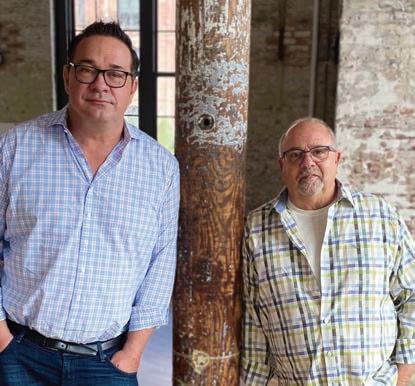
The Trevor Project’s (thetrevorproject.org)
TrevorLifeline is a resource catered to the LGBTQ+ community and individuals who experience mental health challenges as a result of discrimination and harassment in the workplace. Call (866) 488-7386 or text START to 678678.
Detox Local (detoxlocal.com) offers mental health and substance use resources specifically tailored for the American Asian and Pacific Islander community.
Shangri-La Resort and Golf Club in Monkey Island, Oklahoma, was “rediscovered” during the COVID-19 pandemic. As nearby residents stopped traveling, they instead turned to what was local, and that meant holding more banqueting events there.
Last year, banqueting at Shangri-La constituted just less than a third of food and beverage business, and sales are anticipated to rise even further — to 40% to 45% this year.
banquet team — which consists of a banquet chef and five employees, as well as a banquet manager and assistant manager prepares meals for everything from high-end fundraising dinners to corporate meals and family reunions.
Nine areas in the hotel are designated for events, but there are a number of other outdoor areas that can be used, too. “In season it's not uncommon to have five or six events at the same time at one meal period,” Chef Moosmiller says. Plus, staff members are cross-trained. “In the kitchen we utilize any set of hands that has time to help. If the restaurant happens to be slow, staff will help with prep or plating of events; we also use this model on the front of the house as well. If we are slow in the restaurant, staff helps with setup and breakdown of events.”
Banqueting constitutes around 50% of business at The Abbey Resort & Avani Spa in Fontana, Wisconsin, where ChefLuis Quezada,istheexecutivechef.

ACF Chef Jonathan Moosmiller, CMC, AAC (pictured above), joined the resort in August 2021 as the executive director of food and beverage, and loves the range that banqueting offers to him and his team. “It's very creative, and we have such a variety of levels of catering,” he says. Chef Moosmiller notes that his
“We do a little of everything,” he says, though he's only been at the resort since the end of 2022. This ranges from weddings to church groups and a lot of family events. The venue has 22 event spaces, inside and outside. Food is served at sit-down events and passed at cocktail events; some events have action stations. There are continental breakfasts, boxed lunches and everything in between.
In addition to on-site events, The Abbey Resort also caters to events held off-site within 15 miles. Staff from the resort always goes to the venue. “We help
with the setup, and we want to make sure everything represents The Abbey well,” Chef Quezada says. “We have to make sure it is served as best it can be.”
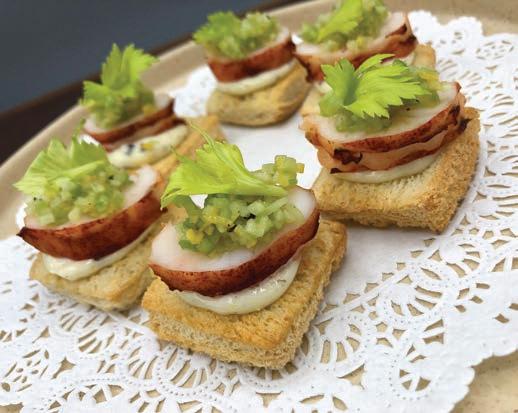
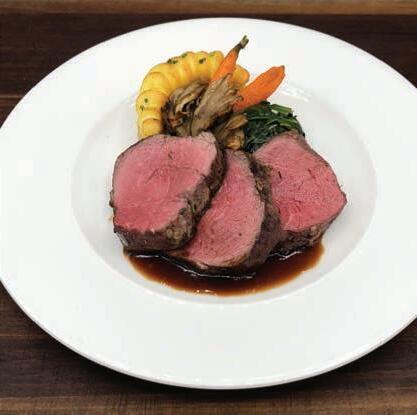
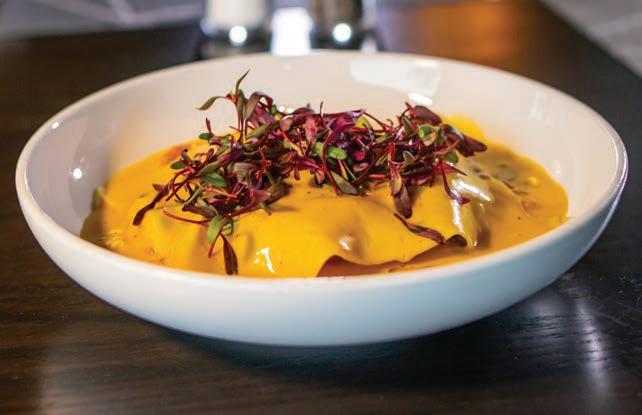
The challenges with off-site events are transporting the food, maintaining its integrity and keeping food in a safe temperature zone. “We have had to be really creative to execute these events,” he says. “If possible, a way to manage the obstacles of off-site events is to utilize a satellite kitchen to finish production. In those cases, we perform all prep work at

“
IF POSSIBLE, A WAY TO MANAGE THE OBSTACLES OF OFF-SITE EVENTS IS TO UTILIZE A SATELLITE KITCHEN TO FINISH PRODUCTION.”
Chef Luis Quezada
The Abbey and then bring those items to the satellite kitchen and work from there.”
At Country Club of Detroit in Grosse Pointe Farms, Michigan, banqueting constitutes about 50% of the $5 million food and beverage revenue with almost all of it done on-site. This is according to ACF Chef Brian Beland, CMC, AAC , executive chef (pictured above), who keeps the off-site business fairly hush-hush but will do small carryout dinners for up to 15 people, or even send a team to cater a small dinner in a member's home. “It's not a business model we promote, but working with the membership and trying to be the most accessible resource to them, we quietly will consider doing some things,” he says. This might include private fundraiser events, special business dinners and private family requests.

Chef Quezada's favorite banqueting go-to’s, he says, are American and international barbecue items for casual
events, and braised dishes for formal meals “because they present well.”
His favorite events are weddings. “It's a special day for the couple; we consider it an honor to be part of such a personal event,” he says. But he also loves the wide range of tasks that working at a resort offers. “It's always something different,” Chef Quezada says, “and it makes it more interesting for me as a chef because it's not like working in a restaurant where you do the same thing over and over. Here you have the opportunity to be doing an Italian wedding today, then a business group with American food tomorrow, then a Latin lunch the next day. We have so much freedom.”
One thing to be aware of in banqueting events is allergies and intolerances, Chef Moosmiller says, and his sales team tries to get ahead of those as much as possible. The difficult ones, he says, are the unplanned ones. To keep everyone happy, “we plan for a percentage [of special meals] over because there is always that person that becomes vegetarian as soon as the entree comes out.” He tries to make sure special meals cover a lot of bases, such as glutenfree and vegetarian, to suit last-minute orders, and he tries to always have things on hand he can pull up quickly.
“IT'S A SPECIAL DAY FOR THE COUPLE; WE CONSIDER IT AN HONOR TO BE PART OF SUCH A PERSONAL EVENT.”
Executive Chef Brian Beland, CMC, AAC
What's important, he says, “is that the special meals are as good as the rest of the meal.” If they get requests for celiac meals, he'll designate one kitchen employee to handle that whole meal “so there's no chance for cross-contamination.”


Chefs Quezada also takes special diets seriously. He might use almond milk for sauces so they are dairy-free, and vegan stock in soups. Chef Beland, meanwhile, might dust a protein with gluten-free flour, which, he says, “doesn't affect the outcome of the dish.”
Chef Beland's team expects 10% to 15% of a banqueting group to have allergies, and no one calls ahead anymore, so he tries to make sure his staff always has food on hand to meet different needs. This might mean the banqueting team will need to prepare 110 dishes for a 100-person meal, but this, he says, allows them to have better meal execution and to keep stress levels down in the kitchen. “Plus we always look to member and guest satisfaction,” he says.
Regularly scheduled events at Country Club of Detroit range from business lunches to Easter brunches and
the ever-popular weddings. While Chef Beland says, “I don't pull out my knives as much as I used to,” he loves running a full food and beverage team and having so many different irons in the fire.
“It's all about empowering our team leaders to run their services. I'm a support system, trying to think a week, a month, a year, five years down the line,” he says. “I'm the visionary for our department and I provide a lot of direction for the club.” Chef Beland makes sure all restaurant cooks and chefs are trained and can partake in banquet services.
He also loves finding the right job for the right person. Having so many different things going on, he says, “allows us to recruit a lot of different people to our culinary team and find them a spot they enjoy. They might like consistency and the same thing day in, day out; they might like banqueting, with its known quantities; or they might prefer the hustle and bustle of the restaurant side. I like watching individuals grow, and I'm fortunate to do it through my passion with the kitchen.”
ACF Chef Jack Birren, CEC, chef-instructor at Waukesha County Technical College in Pewaukee, Wisconsin, cherishes his role as an educator and recognizes the impact he can have on his students. It’s that passion and sense of responsibility that helped earn him the title of ACF’s 2022 Chef Educator of the Year, an award presented to him at last year’s National Convention.
Chef Birren believes that his role as an educator goes beyond the classroom. He uses his very personal experience with a life-threatening illness to inspire others to take precautionary steps to safeguard their health; he has been in remission after a fight with colorectal cancer and Lynch Syndrome, a genetic predisposition that plagued him, as well as other family members.
“When we were dating, my wife, Lisa, would say, ‘You’re going to die with the way you drive,’” Chef Birren says. “I would smirk and respond with, ‘Nope, I’m dying of cancer like the rest of the men in my family.’”
Fortunately for his family — and his students — Chef Birren survived his 2016 bout with cancer and wants to serve as an inspiration to others who may have to battle a similarly insidious disease.
“I said to my wife that I don’t care what happens to me, but I want others
to look at you, Nick (his son) and me and say, ‘I want to go through this (a serious illness) like the Birrens did,’” he says. “I want us to be an inspiration.”
During the height of his battle, Chef Birren managed to miss only three days of classes in the spring semester, having taken most of winter break to go through treatment — an accomplishment he is most proud of.
“There were days when my face was as white as my chef’s coat, but I went in to teach,” he says. “That really kept me moving.”
Not that it was easy. “The chemo I was on made me very susceptible to the cold, so handling cold product, like chilled beef or chicken or fish — despite me wearing layers of gloves — was extremely difficult and painful,” he says.
It was his love of and passion for education that motivated him during this tough time. Chef Birren’s journey in culinary education began when he was a student at Johnson & Wales University in Providence, Rhode Island. During that time, he was accepted into the Teaching Assistant and Fellow Scholarship Program where he worked with culinary instructors in labs educating the students. He also competed and medaled in several competitions in New York and Seattle.
After receiving his bachelor’s degree in culinary arts in 1999, Chef Birren was one of 13 students awarded a full-ride scholarship for a master’s degree through the Management Development Program at Johnson & Wales, during which time he served as assistant manager at one of the university’s dining facilities.
“That’s when the lightbulb went on,” says Birren, who graduated from that program in 2001 with a master of arts degree in teaching. “I was teaching externship students at the restaurant and receiving so much gratification from it. That’s when my path became clear.”
A native of Antioch, Illinois, Chef Birren found his way back to the Midwest, where in 2010, he started teaching garde manger part-time at Waukesha

County Technical College. In 2011, he began teaching there full-time.
And as his career progressed, Chef Birren came to a distinct realization about chefs. “Chefs are always teaching,” he says. “Whether it’s in school or on the job, we’re always helping others in culinary to be better in their profession. In my experience, the more time I spend helping students, the easier my job becomes.”
Chef Birren has helped students of varying ages and backgrounds. “For example,” he says, “probably my best student was a gentleman who had his BA in accounting and worked for a hospital. He came in with a passion for culinary and a focus, and after he graduated, landed a job right out of college at one of Milwaukee’s best restaurants.”
With some students, however, Chef Birren notices a lack of focus — even some who freeze when it comes time to repeat a dish after a lecture and demo. “So, I stop and say, ‘OK, let’s talk about this.’ And then, most of them get it. But I did have one student who simply didn’t get virtually anything the whole semester. I thought there was no way he
was going to pass. Nothing was clicking for him. But on the day of his practical, everything clicked and he passed. That’s why you never give up on students.”
Chef Birren’s favorite days of each semester are the first two days of classes and the two days of graduation ceremonies. “My students will never have the first day of this particular class again, so I try to be as hyped up as possible that first day or so,” he says. “I want them to get excited and to feel the passion. Every student is here for a different reason. As a chef-instructor, I feel it is my job to find what that reason is and instill in them the passion, dedication and confidence that it will take to get them to reach their goal.”
When students walk across the stage at graduation, Chef Birren welcomes them to the profession in a unique way. “While they’re students, the only social media I will interact with them on is LinkedIn, because it’s a professional site,” he says. “But when they cross that stage, they are my peers, and as they cross, I send them a friend request on my other social media [platform].”
Outside of teaching, Chef Birren remains active with ACF, having earned his CEC designation in 2014 and coached secondary and post-secondary culinary hot food teams to numerous awards. He also currently serves as vice president of the ACF Chefs of Milwaukee chapter for a term that will conclude next year.
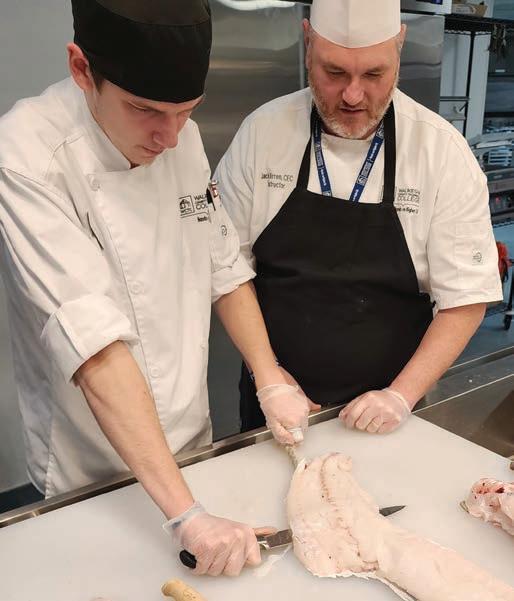
Next up, Chef Birren, who is cancerfree, will be educating a very different audience than his culinary students. “I’ve been asked to speak to Congress about how they can help educate and, therefore, help reduce early-age onset of colon cancer,” he says. “I can speak very personally about this, since it’s affected me and so many males in my family.”
As with every other educational opportunity he embraces, Chef Birren will approach this challenge with the same passion. It’s likely to pay off.

The last plate of the chef’s tasting menu has been cleared. The highly anticipated dessert arrives. It’s a plate that has a golden-hued, scorched tower of meringue, forming a perfect insulator to the creamy ice cream underneath, resting on a light and delicate sponge and served with a touch of crunch and smear of tangy apricot. This is baked Alaska.
It was Chef Charles Ranhofer of Delmonico’s in New York, who in the late 1860s was among the first to introduce baked Alaska in the United States. The name for his version, Alaska/ Florida, paid homage to the temperature extremes found in the U.S.’s then-newly acquired frozen tundra and the tropical landscape of Florida. But the concept of the dessert started long before Chef Ranhofer’s rendition.
Historians suggest that the history of baked Alaska begins with noted American physicist Benjamin Thompson Rumford , who in 1804 discovered the insulation properties of meringue and developed his “omelette surprise”— ice cream encased in a baked, sugary shell. Countless others lay claim to inspiring the modern makings of the dessert, including famed French/ British Chef Alexis Soyer, who in 1846
ACF Chef Glenncombined meringue with ice cream at a dinner for Ibrahim Pasha of Egypt. French food writer Baron Leon Brise , who in 1866 suggested in his weekly newspaper column that the creation of the dessert was introduced into the country by a French Chef at the Grand Hotel in Paris named Balzac , who learned the technique of “baking ginger and vanilla ices in the oven” from visiting Chinese chefs. Recipes featuring various fruits and creams encased in meringue can be found in numerous cookbooks, including Aunt Mary’s 1855 cookbook “The Philadelphia Housewife” and “The Original Fannie Farmer Cookbook,” published in 1896.
Although some food historians contend Chef Ranhofer’s version featured a walnut spice sponge, according to page 1,007 of his tome, “The Epicurean,” the reader is instructed “to prepare a very fine-vanilla flavored Savoy biscuit paste.” It is then baked in single-serving rounds, hollowed out, flavored with apricot marmalade and filled with a tapered cylindrical mold of banana and vanilla ice creams. Once the molds are frozen, “unmold and lay them in the hollow of the prepared biscuits;
//
By
Rinsky, CEPC, CEC, CCE
Modern Baked Alaska with Japonaise, Citrus Biscuit, Creamy Caramelized Banana and Milk Chocolate Ganache, Banana and Nougatine Ice Cream and Swiss Meringue For the full recipe, visit acfchefs.org.
keep in a freezing box or cave,” the recipe instructs. The biscuit-ice cream combination is then to be covered in meringue and “pushed through a pocket furnished with a channeled socket and colored in a hot oven for two minutes.” In my personal renditions of baked Alaska, I like to use a wood-burning oven to “color,” or brown, both single servings and larger-scale, party-friendly renditions of the dessert.
VISIT ACF CHEF GLENN
RINSKY’S YOUTUBE CHANNEL, GRAND CUISINE!, WHERE HE EXPLORES THE ORIGIN OF BAKED ALASKA AND PREPARES IT AS IT WOULD HAVE BEEN PREPARED IN THE CAVERNOUS KITCHEN OF DELMONICO’S, ACCORDING TO CHEF RANHOFER’S RECIPE FROM HIS CULINARY TOME, “THE EPICUREAN.”

For my updated rendition (see recipe below), I also start with a Japonaise base that’s topped with a citrus-based savoy biscuit and a creamy and caramelized banana and milk chocolate ganache. I then encase the ice cream with a Swiss-style meringue, studded with an almond nougatine to increase the crunch and wow factor. For this method, I use a blow torch to “color” and lightly brown the shell, which is then served with a mango sauce and more crumbled nougatine garnish. Timeless and stunning, classical or modern, baked Alaska shows the versatility of the pastry chef and gives diners the exciting combination of hot and cold in one bite.
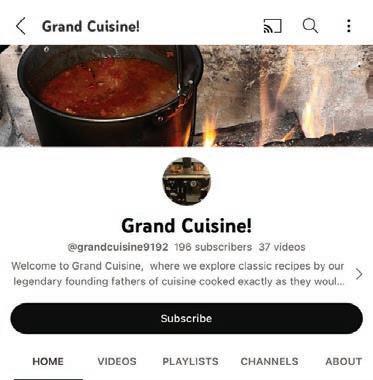

As of press time here is the list of those who are making convention possible. Download the ACF Chefs app for more details about our sponsors and to see the list of exhibitors for the trade show.
Platinum Sponsors



Gold Sponsors




Silver Sponsors
Custom Sponsors


We’re only a couple months away from the 2023 ACF National Convention, taking place July 16-19 at the Ernest N. Morial Convention Center! Don’t miss this chance to attend one of the most highly anticipated annual gatherings of chefs, students and foodservice professionals in the country, with world-class presenters, demos, demos and more demos, competition kitchens and more than 60 sponsors displaying the latest and greatest food products, equipment and more. Full registration includes a program badge with access to all one-hour seminars and demos, as well as the general session, trade show, networking breaks and meals.
SUNDAY, JULY 16
Welcome Reception
6:30 p.m. – 8:30 p.m.
Join us at the opening party held at the beautiful New Orleans Culinary and Hospitality Institute (NOCHI). This is a great way to reconnect with your fellow chefs, meet new friends and taste exciting products from new and returning sponsors. Please note that tickets for the welcome reception are not included in the Advanced Educator Summit package.
MONDAY, JULY 17
Awards Luncheon
1:15 p.m. – 2:15 p.m.
ACF National President Kimberly Brock Brown, CEPC, CCA, AAC, will present this year’s Presidential Medallion and Cutting Edge Award recipients.
ACF Chapter Leaders Meet-Up
5:45 p.m. – 7 p.m.
Mingle with other ACF chapter presidents and board members at this special gathering.
ACF National Competitions
10 a.m. – 4 p.m., NOCHI
TUESDAY, JULY 18
AAC Annual Fellows Meeting
7 a.m. – 9 a.m.
Trade Show
10 a.m. – 3 p.m.
Taste products and explore the latest and greatest from more than 60 sponsors this year. Join us for the ribbon cutting at 10 a.m., to kick off the show, concluding with a happy hour from 2:30 p.m. – 3 p.m.
ACF National Competitions
10 a.m. – 4 p.m., NOCHI
Chef Educator of the Year Competition
10 a.m. – 4 p.m., New Orleans Ernest N. Morial Convention Center
2023 American Academy of Chefs Annual Induction Dinner
6 p.m. – 11 p.m.
Connect with other AAC fellows and welcome new inductees into the fold at this not-to-be missed seated, multi-course dinner, held this year at the Marriott Warehouse Arts District Hotel. $195 per person. Black-tie attire is requested. Buy tickets at acfchefs.org/Events/Convention

WEDNESDAY, JULY 19
Building Future Leaders Meet-Up
7:30 a.m. – 8:30 a.m.
AAC Spouses/Significant Other Luncheon
11:30 a.m. – 2:00 p.m.
This year’s luncheon will take place at Restaurant R’evolution. $60 per person. Transportation will be provided from the
Marriott New Orleans Warehouse Arts District. Buses will leave promptly at 11:15 a.m. Limited seating. Buy tickets at acfchefs.org/ACF/Events/Convention.
President’s Gala Reception 6 p.m. – 10 p.m.
This event begins with a reception followed by a seated dinner and awards at 7 p.m., when President Brock Brown announces the winners of the national competitions, including Chef of the Year, Pastry Chef of the Year, Student Chef of the Year, Student Pastry Chef of the Year, Chef Educator of the Year and Student Team of the Year, as well as the Chef Professionalism, Hermann G. Rusch Chef’s Achievement, L. Edwin Brown Leadership and Chapter of the Year awards. Expect some celebrations and dancing to follow, just like last year!
These events are not included in convention registration.
Competition Seminar
Saturday, July 15
Participants will gain an understanding of not only judging criteria but also best practices in the competition kitchen and tactics that consistently reach the highest place at the podium. Register at acfchefs.org/Competitions.
Sunday, July 16
9 a.m. – 4:15 p.m.
Kicking off ACF’s 2023 MasterCraft Summit Series, the Culinary Educator Summit will be held a day before convention starts at the Ernest N. Morial Convention Center. Secondary, post-secondary, workforce development chef/ instructors and CTE professionals of all levels are invited to participate as we launch our one-day ACF professional development summit just for culinary educators (earn eight CEHs upon attendance and a specialized certificate upon completion of the written exam). In a supportive and collaborative environment, we’ll challenge both new and more seasoned culinary educators to expand their areas of expertise while sharing their passion for teaching future chefs and cooks. Join us for a day of demonstrations, panel discussions and seminars on topics such as curriculum design, culinary competitions, creating advisory boards, mental wellness, industry certifications and technology in the kitchen classroom. To register and for more information on this and other ACF MasterCraft Summits planned for this year, visit acfchefs.org/Events or download/log in to the new ACF Chefs mobile app.
Sunday, July 16 – Wednesday, July 19
Compete to become the next national champion in the 2023 ACF Culinary Knowledge Bowl! Teams compete in a “Jeopardy”-style competition with questions covering topics such as cooking techniques, nutrition, baking and safety/ sanitation. Visit acfchefs.org/Knowledgebowl to learn more and register your team today! The deadline to apply is May 15.
Sunday, July 16
Interested in volunteering at the 2023 ACF National Convention? We want to hear from you! It’s easy to fill out the form online here to get started.
Tickets to this VIP experience include fresh coffee and snacks during convention, as well as meet-ups and book signings with celebrity speakers and special guests. Gold Pass holders will also receive a gift bag full of goodies to take home. Select this $150 upgrade when registering for convention at acfchefs.org/Events or through the ACF Chefs mobile app.
Hotel Information
The New Orleans Ernest N. Morial Convention Center is conveniently located within close proximity to a variety of hotel options. ACF has negotiated a discounted room rate for attendees at the Courtyard New Orleans Downtown/ Convention Center, the New Orleans Marriott Warehouse Arts District and SpringHill Suites New Orleans Downtown, all of which are located just a block from the convention center. Visit acfchefs.org/ACF/Events/Convention to learn more.
Take a look at just some of the speakers and session topics planned for this year’s convention! Check out the full schedule and descriptions at acfchefs.org/Events and through the ACF Chefs mobile app.
MONDAY, JULY 17
Opening Session with Chef
Justin Sutherland
9 a.m. – 10 a.m.
Chef Justin Sutherland, a Minnesotabased chef, restaurateur and TV personality and winner of Food

Network’s “Iron Chef” will share his insights as he prepares sukiyaki, a Japanese dish that was very important to him growing up. Ask your questions and learn more about Chef Sutherland’s new book, “Northern Soul.”
Breakout Sessions
10:30 a.m. – 11:30 a.m.
Focus on Pastry Techniques: Chocolate Amenities that WOW!
ACF Pastry Chef Chris Cwierz, MBA, shares his tips on how to build modern chocolate pieces with height and artistry.
Global Cuisine Spotlight: Gastronomy of Mexico
Mexican chef and culinary educator Alejandra Kauachi explores the various flavors of her culture’s cuisine during a demo.
Noon – 1 p.m.
Regional Cuisine Spotlight: The Flavors of Northern Appalachia
Discover the lore of Ohio country cooking with ACF Chefs
Alfonso Contrisciani, CMC, and Otto Borsich as they present modern interpretations of this regional cuisine using such products as heritage pork, pawpaw, mushrooms and local fish.
Advanced Bread Baking Techniques: Porridge Breads
Certified Master Baker Lilla Bernal, CMB, associate professor at the Culinary Institute of America, will discuss ways to incorporate different types of grains into breadmaking during this demonstration.
Advanced Culinary Concepts: Dry-Aged Steaks
Chef Gerald Sombright, executive chef at The Dunes of Naples Country Club, shares how to develop the layers of flavors that come along with dry-aging beef.
2:30 p.m. – 3:30 p.m.
During this presentation, Canadian Chef Jordan Wagman, a James Beard nominee and author, removes the mystique around cooking with cannabis as he demonstrates the basics of infusions, cannabinoids and terpenes.
Native American Cuisines & Indigenous Cultures: Foods of Resilience
ACF Chef Lorencita Billiman of Navajo Technical University presents the story of indigenous food in America as she demonstrates a recipe for the controversial yet wellknown frybread.
Spirits of New Orleans: The History and Flavors of Gin & Absinthe
Andrew Snyder, viticulture and enology program director and distillation science professor at Grayson College, discusses the history of New Orleans apothecaries and how to work with classic spirits like absinthe and gin in modern mixology.
The Future of Food & Health; Nutrition & Culinary Medicine
ACF Chef Leah Sarris, RD, LDN, MBA, a pioneer in the culinary medicine movement, leads a panel with our association partners Association of Nutrition & Foodservice Professionals, Association for Healthcare Foodservice and Collegiate & Professional Sports Dietitians Association.
4 p.m. – 5 p.m.
The Trinity of Louisiana Cooking: Gumbo, Étouffée and Jambalaya
Join legendary ACF Chef John Folse, CEC, AAC, HOF, HBOT, for this very special session on the flavors and history of Louisiana cooking. During this presentation, Chef Folse will share his insights on traditional dishes such as étouffée, gumbo and jambalaya.
Creole, Cultures & Cuisines: Celebrating the Vibrant Flavors of the Caribbean
James Beard-nominated ACF Chef Chris Viaud, owner of Greenleaf and Ansanm, and fellow Haitian Chefs Alain Lemaire and Sebastian Salomon discuss the history behind and ingredients of Creole Caribbean cuisine.
Focus on Seafood: For the Love of Oysters
Whether served cooked or raw, in shooters or in stews, learn all about the salt-water bivalve molluscs that are a New Orleans favorite! ACF Chef/restaurateur Matthew Dolan, author of "Simply Fish," will lead a sensory experience during this session.
WEDNESDAY, JULY 19
General Session
9 a.m. – 10 a.m.
Ti Adelaide Martin & Chef Meg Bickford: Commander's Palace
The duo discusses this famed NOLA institution’s rich history. 10:30 a.m. – 11:30 a.m.
10:30 a.m. – 11:30 a.m.
ACF Chef Drew Sayes, CMC, explores how proper mise en place can be applied to certifications, competition and your everyday life, and he’ll offer a different perspective on the importance of understanding various staple ingredients.
Brother Luck, the James Beard-nominated chef/restaurateur, TV personality, mental health advocate and author of "No Lucks Given: Life is Hard But There is Hope," will share insights on the importance of wellbeing for those who work in the culinary world.

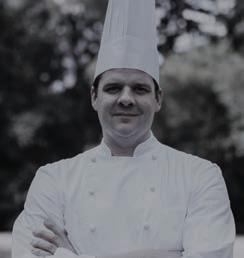
ACF Chef Andy Chlebana, CMPC, CCA , author of “The Advanced Art of Baking & Pastry” and a past ACF Pastry Chef of the Year, whose works of sugar art have been showcased on the Food Network and in international competitions, shares his techniques for shaping and sculpting the sweet ingredient.
1 p.m. – 2 p.m.
Join 2022 ACF Chef of the Year Danielle Hughes, CS1, U.S. Coast Guard, as she shares professional techniques, tips and best
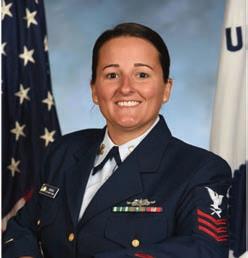

practices on how to compose eye-catching plate presentations based on taste, texture, temperature and visual appeal.
ACF Chef Hari Pulapaka, CEC, Ph.D., presents a demo featuring traceably transparent and sustainable ingredients to illustrate the power of telling stories through culinary art.
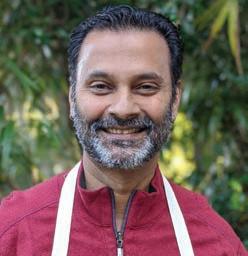

New Orleans-born and Louisiana native ACF Chef Amy Sins has been determined to help others after losing everything when the levees failed in the aftermath of Hurricane Katrina. Founder of the relief organization FillTheNeeds.org, Chef Sins will share tips on how to safely support others during national disasters.
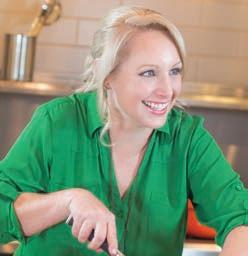
Military chefs representing the U.S. Coast Guard and U.S. Army offer tips on how to reduce food waste along the entire spectrum of production, from the farm to inside our kitchens.
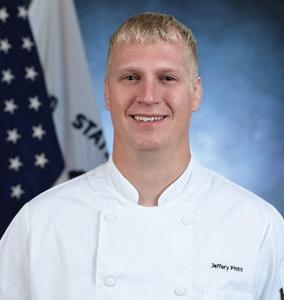
Which Aperitivo cheese by BelGioioso® is described as earthy, full flavored and having a soft texture?
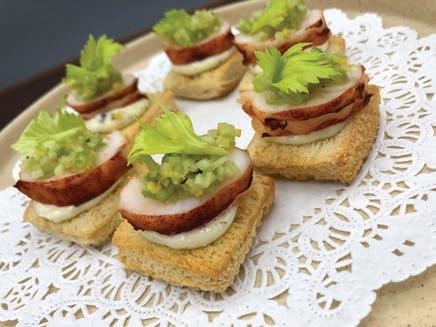
a. Crescenza Stracchino™
b. Italico™ Washed Rind Cheese
c. Creamygorg® Gorgonzola Dolce
d. A rtigiano® Vino Rosso
ACF Chef Vanessa Ruiz, CFPC, recently received which regional award?
a. Northeast Region Student Pastry Chef of the Year
b. Central Region Chef of the Year
c. Western Region Student Chef of the Year
d. Southeast Region Pastry Chef of the Year
Which chef will kick off the 2023 ACF National Convention at the opening session in New Orleans?
a. Chef Chris Viaud
b. Chef Alejandra Kauachi
c. Chef Justin Sutherland
d. Chef Lorencita Billiman
What stand-out dessert in Hawaii is similar to a raised yeast donut hole that is deep fried and rolled in sugar?
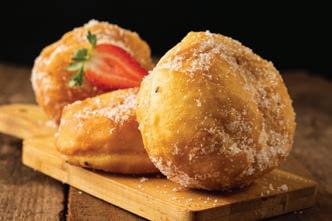
a. Beignet
b. Churro
c. Balushahi
d. Malasada
Gran Canaria is a cheese made from which type of milk?
a. Sh eep
b. G oat
c. Cow
d. A ll of the above
What color, having spiritual meaning with African tribes brought to America and enslaved, is associated with Juneteenth and is the hue of drinks such as kola nut and hibiscus teas.
a. G reen
b. Yellow
c. R ed
d. O range
ACF Chef Andy Chlebana, CMPC, will be presenting on what topic at the 2023 ACF National convention?
a. Sugar Tips & Tricks; Crafting Edible Art
b. Advanced Bread Baking Techniques: Porridge Breads
c. Focus on Pastry Techniques: Chocolate Amenities that WOW!
d. Advanced Plating Techniques
According to Chef John Franke, kitchen operations need which three things to operate well?
a. Policy, procedure, and training
b. Systems, procedure, and training
c. Training, policy, and product
d. People, product, and systems
Formed in 2021 by ACF Chefs Brian Tatsukawa, CEC and Robert Witte, CEC, CCA, AAC, the Four Corners ACF chapter encompasses and portions of Arizona, Colorado, and Utah.
a. Wyoming
b. New Mexico
c. Texas
d. Nevada
Which cut of beef is used in Chef Darren Thompson’s “Southern Swangin’ Steaks,” a Juneteenth recipe passed down from his grandmother?
a. Knuckle
b. Ox tail
c. R ump
d. Ch eek
Because of its buttery sweetness, which cheese would pair well with the almond notes of an amaretto sour, according to certified cheese sensory evaluator Molly Browne?
a. Butterkäse
b. G ran Canaria
c. Gouda Foenegreek
d. 15-year Cheddar
While they are enrolled in his classes, what is the only social media platform on which ACF Chef Jack Birren, CEC, will interact with his students?
a. Facebook
b. Chef’s Table
c. L inkedIn
d. Instagram
What does ACF Chef Robert Marilla, CEC, AAC, use as the grand finale in his modernized version of paella?
a. R ed snapper
b. Duck
c. Soft-shell crab
d. R abbit
Chef Charles Ranhofer, of Delmonico’s of New York, was among the first to introduce what dessert in the United States?
a. Baked Alaska
b. Cherries Jubilee
c. Bananas Foster
d. German Chocolate Cake
See the rest of the questions, finish the quiz and earn four CEHs toward your certification on ACF’s new Online Learning Center at acfchefs.org/olc









Jones Dairy Farm is a 7th Generation family owned and operated company located in Fort Atkinson, WI. For more than 130 years, we’ve been using real, natural ingredients, original recipes and time honored traditions to create distinctive and timeless products. Our All Natural Sausage, Naturally Smoked Hams and Dry Aged bacon will inspire your creations and delight your customers. We guarantee premium quality and your satisfaction.
For More Information Visit:




JonesDairyFarm.com/Foodservice







